Forests for All
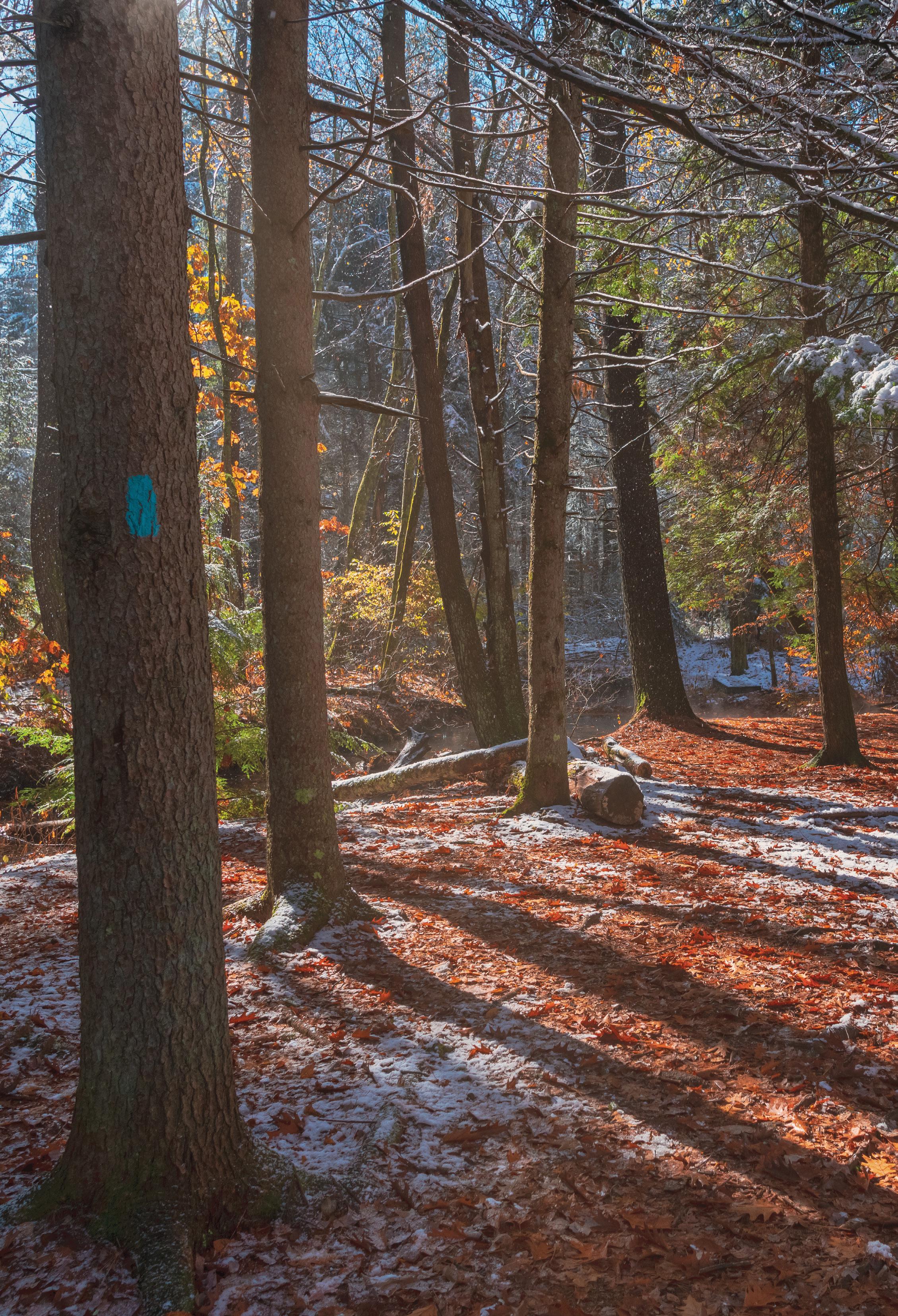
WINTER 2 02 3 CO NNE CT ICUT
Land Acknowledgment Statement
CFPA acknowledges we are on the traditional lands of the Mashantucket Pequot Tribal Nation, the Mohegans, the Eastern Pequot, Schaghticoke, Golden Hill Paugussett, Nipmuc, and Niantic peoples. We pay our respect to the Indigenous people who are no longer here due to colonization, forced relocation, disease, and warfare. We thank them for stewarding this land throughout generations. We recognize the continued presence of Indigenous people on this territory who have survived attempted genocide, and who still hold ties to the land spiritually and culturally. We shall be good stewards of the land we all call Quinnentucket, Connecticut.
CONTRIBUTOR’S Spotlight
Hanna Holcomb has been a regular contributor to Connecticut Woodlands since 2017, writing articles that explore topics from conservation to recreation to gender in the outdoors. For the past several years, the Woodstock, Conn., native and Wesleyan University graduate has called the Rocky Mountains “home.” An avid skier, trail runner, and backpacker, Hanna is also a passionate naturalist who spent the past field season working in the Greater Yellowstone Ecosystem, and she recently accepted an environmental educator position with the Teton Science Schools, based in Jackson, Wyo. We caught up with Hanna to learn more about her passion for wildlife and time spent out West.
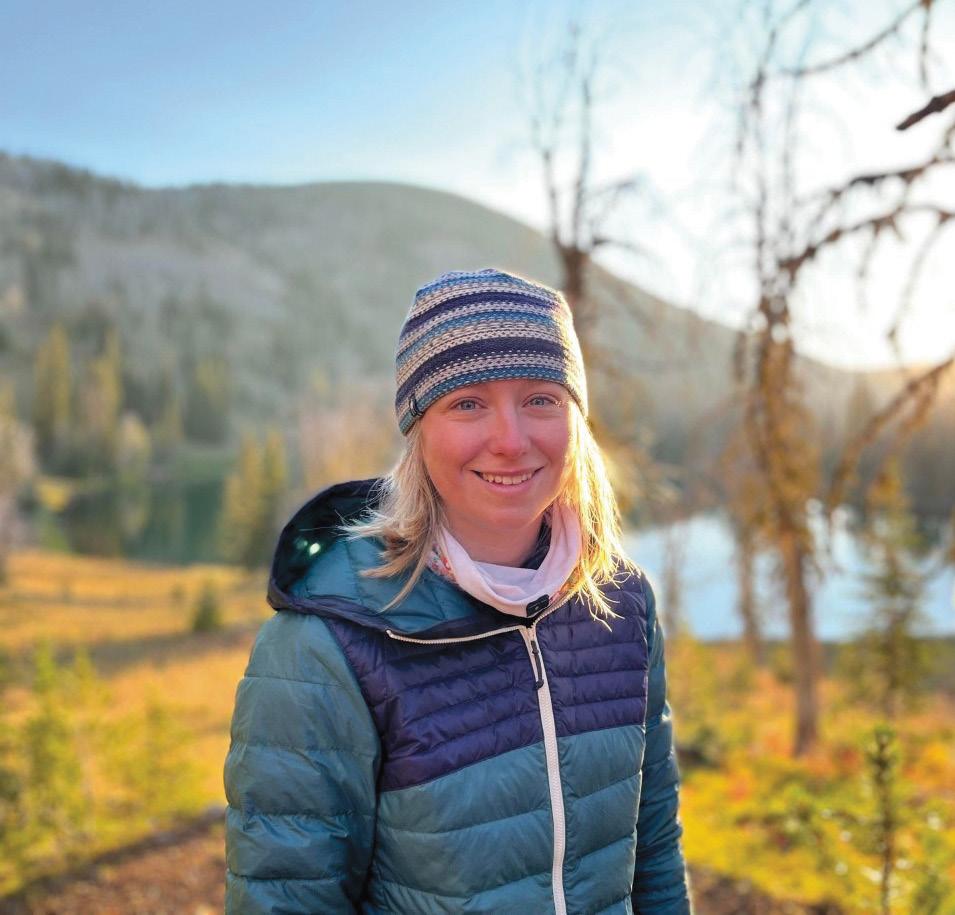
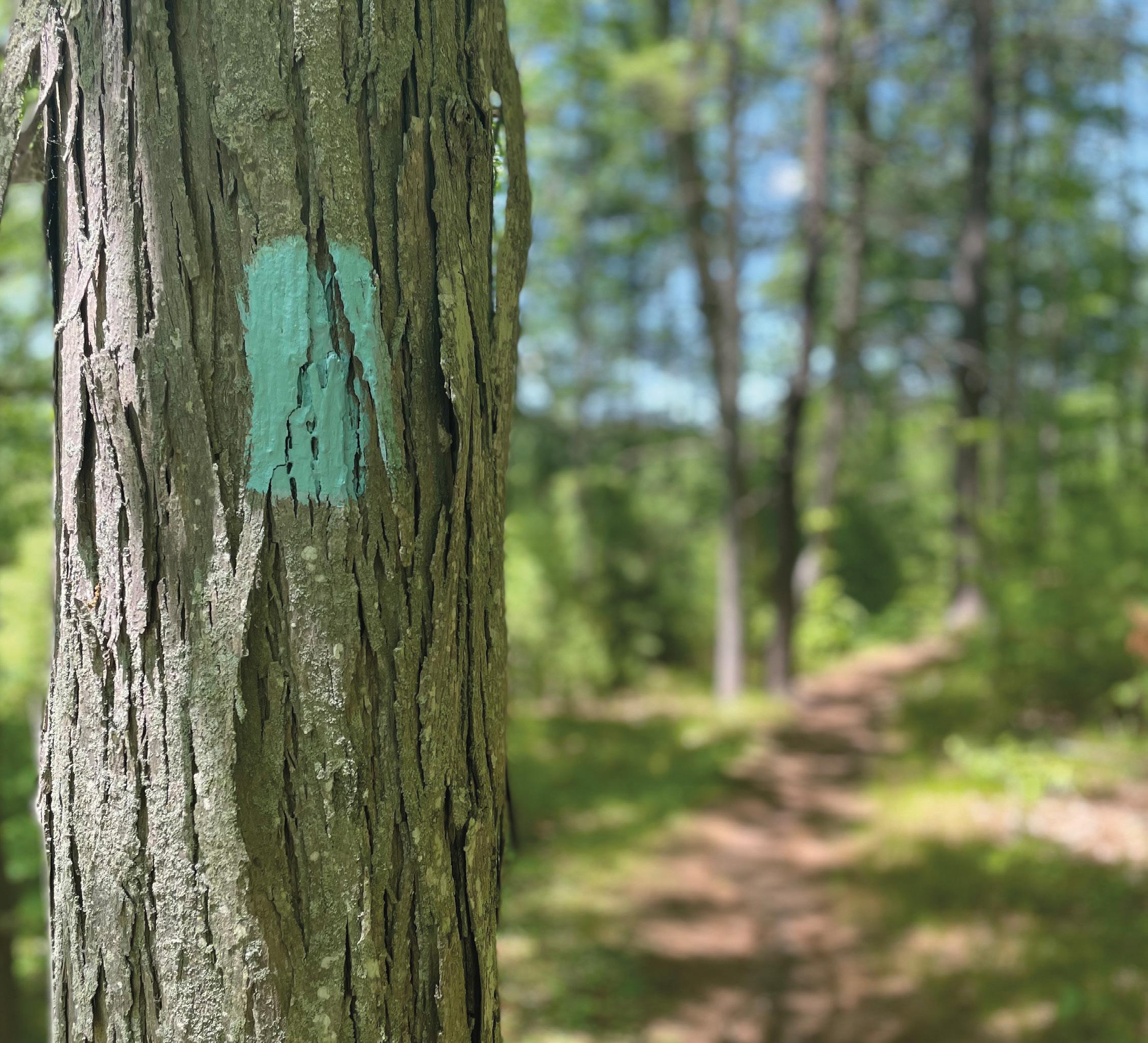
2 Connecticut Woodlands
Jaymi Heimbuch, conservation photographer

In this Issue
By Eric Hammerling
By Joe Neafsey
By Timothy Brown
How has living in the Rocky Mountain West changed your perspective on conservation issues?
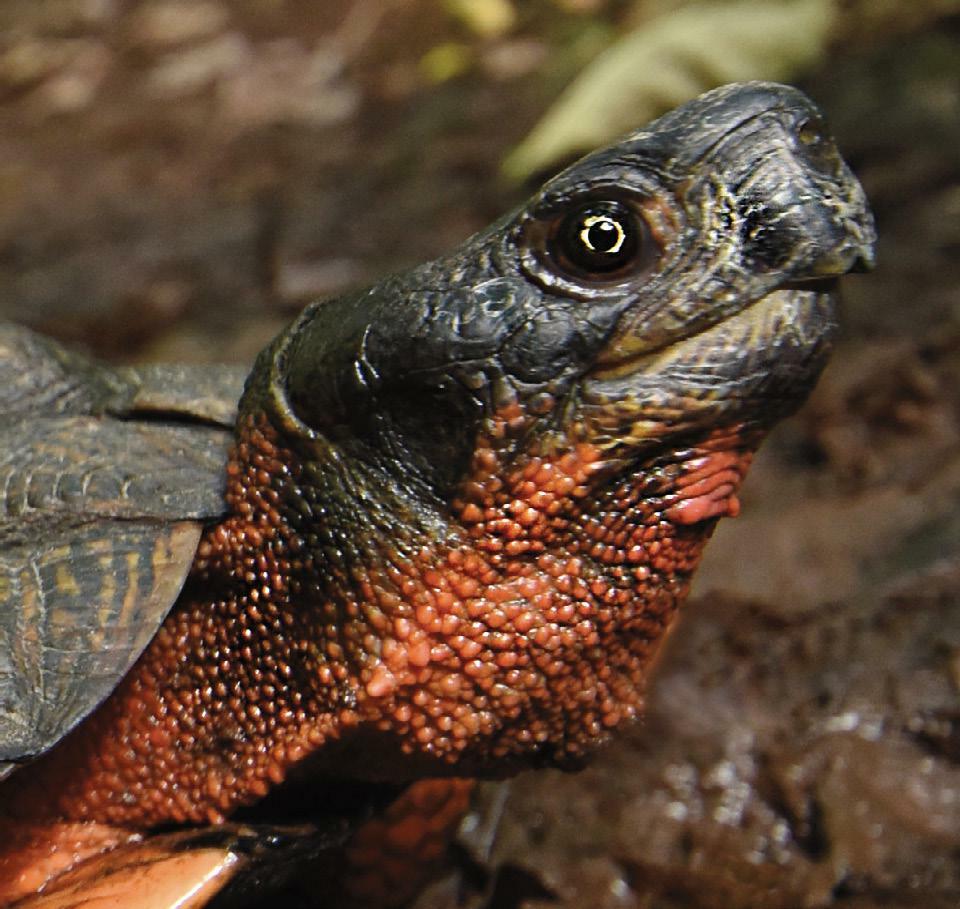
I’ve gained a deeper appreciation for how complicated conservation issues can be. Many issues, if not all, don’t have easy right and wrong solutions. There are many perspectives and potential impacts, from ecological to economic to cultural, to account for.
Predators, including coyotes, are highly controversial. Why is it important that people learn to live with these creatures?
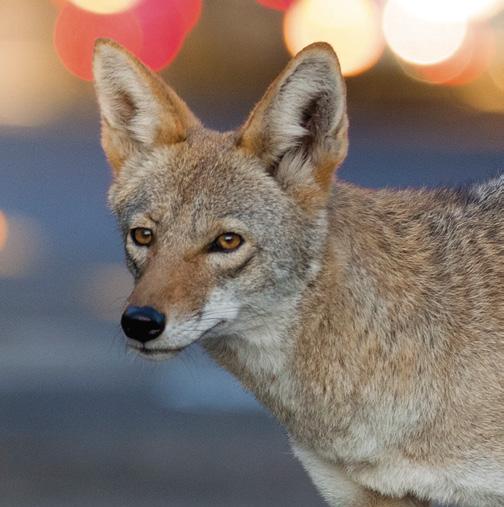
They play such important roles in the ecosystem. Without them, prey species can become overabundant which causes a whole slew of far-reaching effects. I think it’s natural to be worried about living among predators, but without them ecosystems can’t function like their supposed to. Beyond that, a lot of our predators have really fascinating biology and histories and it’s just cool to catch glimpses of them.
What do you miss most about living in Connecticut?
I of course miss living near my family, but I also miss the feeling of being in Connecticut’s forests. The humid, rooty, rocky, and tree-tunneled trails will always feel like home and are completely different from the arid and exposed trails I spend most of my time on here.
facebook.com/ctforestandparkassociation twitter.com/ctwoodlands instagram.com/ctforestandparkassociation 860-346-TREE ctwoodlands.org info@ctwoodlands.org
ctwoodlands.org 3
4 Editor’s
5 From the
Note
Statehouse
6 On the Trail
8 Creating a More Inclusive Environment
12 Coexisting with Coyotes
16 Advancing Conservation One Image at a Time: A Conversation with Jaymi Heimbuch 17 Heavenly Blue
18 Turtle Tracks
By Hanna Holcomb
By Carol Chaput
23
By Laurie D. Morrissey
Pathways On the cover: The Blue-Blazed Shenipsit Trail hugs the banks of the Tankerhoosen River at the Belding Wildlife Management Area. Photo by Steven Kornfeld.
Winter 2023 Volume 88/No. 1/ISSN #00106257
When we first moved to New Haven’s East Shore neighborhood, just a couple of blocks from Long Island Sound, we were excited to discover a variety of wildlife our yard. There are several parks in the area, so we weren’t too surprised to find deer, turkey, red foxes, raccoons, opossums, and owls living alongside us. But we were startled one night to hear a pack of eastern coyotes nearby, their piercing yips and mournful howls filling an otherwise quiet evening.
Six years later, we still hear them from time to time. We’ll often stop whatever it is we’re doing, crack the windows for a few minutes, and just listen, captivated by their ancient calls. Rather than thinking of them as scary or threatening, we consider the coyotes to be our neighbors, just ones we rarely see.
Connecting with coyotes and other wildlife is one way we’re working to instill environmental values in our kids. Despite growing up in a small city, they spend a lot of time outdoors—hiking, mountain biking, or in the water. I recognize that our kids are privileged to be exposed to all the beauty, joy, awe, and adventure that nature has to offer. Tragically, across the country, many kids do not have access to the outdoors. Getting outside can be expensive and time-consuming, two luxuries that many families cannot afford. Even if kids have access to parks, trails, and beaches, they may not feel like they belong in those spaces because of the color of their skin or other aspects of their identity. For far too long, environmentalists and conservationists have marginalized certain groups of people in their efforts to protect nature. This is not just unethical, it’s counterproductive. If we are to protect open space, mitigate climate change, curb pollution, and safeguard species, we need everyone in this fight.
As Connecticut’s premier conservation organization, CFPA is not only committed to protecting forests and parks, but also to improving equity and access to the outdoors and creating a more inclusive environmental community. I’ll see you outside,
Timothy Brown Editor
The Connecticut Forest & Park Association,
Inc.
The Connecticut Forest & Park Association (CFPA) is a 501c3 nonprofit organization that protects forests, parks, walking trails, and open spaces for future generations by connecting people to the land. Since 1895, CFPA has enhanced and defended Connecticut's rich natural heritage through advocacy, conservation, recreation, and education, including maintaining the 825-mile Blue-Blazed Hiking Trails system. CFPA depends on the generous support of members to fulfill its mission. For more information and to donate, go to ctwoodlands.org
Board of Directors
President
R. Richard Croce, Groton Vice-Presidents
Kristin Connell, Killingworth
David Terry, East Hampton
Treasurer
William Cordner, Simsbury
Secretary
Eric Hammerling, West Hartford
Forester
Jeffrey Ward, Prospect
Robyne Camp, Middletown
Laura Cisneros, Mansfield
Beth Critton, West Hartford
Robert Deptula, Ellington
David Ellis, Wallingford
Laurie Giannotti, Deep River
Alan Hurst, East Hampton
Seth Huttner, Hartford
Peter Knight, Stonington
Michael Proctor, Sandy Hook
Tom Tella, Wolcott
Marcus Ware, Ellington
Staff
Eric Hammerling Executive Director
Beth Bernard Education Director
Alex Bradley Trails Field Coordinator
Clare Cain Trails Director
James W. Little Development Director
Teresa Peters Office Manager
Jeb Stevens Trails Protection Coordinator
Meaghan Strange Development Assistant
Connecticut Woodlands
Timothy Brown Editor

Margaret Gibson
Poetry Editor
Kolk Design Graphic Design
Jake Koteen Photographer
Thanks to photo contributions from Dana Goin, Jaymi Heimbuch, Steven Kornfeld, Sam Lewis, Dennis Quinn, Wolf Conservation Center.
Sustainably printed on FSC certified paper using solar power and LED-UV curable inks, which don’t release harmful VOCs into the atmosphere and can reduce energy consumption by 30% compared to conventional inks.
Connecticut Woodlands is a quarterly magazine published since 1936 by CFPA. The magazine is distributed to members and donors, as well as public libraries and other state and local offices. Advertising local goods or services is welcome. For specifications and rates, visit ctwoodlands.org/rates. To advertise, contact tpeters@ctwoodlands.org or call 860-346-TREE.
Editor’s
Note
4 Connecticut Woodlands
From the Statehouse
By Eric Hammerling
just 83 individuals are responsible for caring for and accommodating public needs at all 110 Connecticut state parks and six nature centers…
According to the Department of Energy and Environmental Protection’s (DEEP’s) most recent estimates, Connecticut state parks welcomed over 13 million visitors in 2022, an increase of approximately 5% over 2021. This continues a positive trend since the Passport to the Parks program was first implemented in 2018—visits in 2021 were up roughly 10% over 2020; visits in 2020 were up by roughly 10% over 2019; and so on.
The successful and popular Passport to the Parks program both enables all Connecticut residents free entry to state parks and forests and also generates $20 million per year to fund state park maintenance and operations through a $5 per year fee that we all support when we register our motor vehicles. This is an incredible bargain for Connecticut residents; prior to the Passport program (2017 and earlier), just one visit to a shoreline park on the weekend would cost $13.
The funding generated by the Passport is essential to pay for more than 500 seasonal workers that DEEP employs between March and October each year to care for parks and nature centers, as well as ensure public safety in other ways (e.g., lifeguards and environmental conservation officer support). The Passport also pays for 35 full-time park staff and the significant expenses associated with trash disposal, ongoing facility maintenance, and other related costs. The Passport is critical to the future of your state parks, and that’s why CFPA continues to fight every year to ensure it remains intact and dedicated to its purpose.
The Passport is doing its job, but 83 is not enough!
Currently there is a cap on the number of full-time state park staff—just 83 individuals who are responsible for caring for and accommodating public needs at all 110 Connecticut state parks and six nature centers, located at Dinosaur, Fort Trumbull, Kellogg, Meigs Point, and Sessions Woods state parks, and at the Goodwin Forest Conservation Education Center (where many CFPA, DEEP, and Friends of Goodwin Forest educational programs are held).
In 2021-22, the most pressing concern for the park system was that over 35% of state park employees were eligible for retirement, and the process of re-filling those
positions—while accommodating ever-increasing public use—would be a massive challenge. The potential for closing facilities during the retirement/re-filling process was very real, but DEEP navigated this challenge remarkably well all things considered, and most vacant positions have been filled.
In 2022-23 and looking forward, now that DEEP’s retirement cliff has largely passed and the system is recovering as new employees come up to speed, we must re-focus on the fact that 83 state park staff is simply not enough.
Over the coming months, you’ll be hearing more about this issue from me and from our partners at the Friends of Connecticut State Parks. Thanks, as always, for your support!
Eric Hammerling has served as the Executive Director at the Connecticut Forest & Park Association since 2008.
ctwoodlands.org 5
…
83
Annual Visitation Almost Doubles 14 13 12 11 10 9 8 7 6 5 4 1984 1990 1995 2000 2005 2010 2015 2019
Full Time Staff Cut in Half 230 210 190 170 150 130 110 90 70 50 1984 1990 1995 2000 2005 2010 2015 2020
IS NOT ENOUGH Park Visitation
Park Staffing
The Shenipsit Trail: From Grahaber Road in Tolland to Gulf Road in Somers
By Joe Neafsey
My wife, PJ, and I first started hiking after we met in college in 1971. Although I grew up in southwestern Connecticut, I had never heard of CFPA or the Blue-Blazed Hiking Trails. When we moved back here in 1976, I remember seeing a blue oval on Route 42 on my way to work. Curious, I stopped on my way home one day and found a small parking lot and kiosk describing the route of the Quinnipiac Trail. I wrote down the address of CFPA (at the time, in East Hartford), became a member, and soon received the 1976 Bicentennial Edition of the Walk Book in the mail. Over the next few years, we hiked along the Quinnipiac, Laurel, Lone Pine, Metacomet, Mattatuck, Naugatuck, Sleeping Giant, Regicides, Westwoods, McLean Game Refuge, and other trails. When we moved to West Stafford, we discovered that the Shenipsit Trail was about five minutes from our house. Within a few months, we hiked the entire 50-mile trail, from the Massachusetts line to East Hampton, Conn.
At a CFPA event in 2017, I happened to sit next to Harry and Weezie Perrine, who manage a northern section of the Shenipsit Trail. I told them I was retired and lived close to the trail, and within minutes, I was recruited to be a trail manager. The northern section of the Shenipsit Trail starts at Grahaber Road in Tolland and runs north through the Shenipsit State Forest to Old Springfield Road in Stafford. My section ends at the state forest entrance on Gulf Road in Somers.
Edgar L. Heermance once said, “A good trailsman always leaves a trail a little better than he finds it.” Although his wording could use some updating, this sentiment summarizes my desire to give back to the trails that have given so much to me and my family over the last 46 years. I’m also grateful to Hugh Owen who generously shares his ideas, time, and labor to help clear blowdowns, trim brush, clean drainageways, and place steppingstones across muddy sections of the trail.
“Shenipsit” is a Mohegan word that means “at the great pool,” likely a reference to Shenipsit Lake. The trail follows foot paths, cart paths, tote roads, and haul roads through the
woods. From the 16th through the early 20th centuries, these forests were major charcoal production areas used to make iron. Today you can still see many charcoal mounds along the trail, especially along the yellow and blue by-pass trail. Look for subtle undulations—roughly 30 feet in diameter— of black soil rather than brown. Colliers who tended these mounds lived in nearby shelters called hovels. A little probing can often yield small charcoal fragments.
Also, the enduring work of the Civilian Conservation Corps (CCC) can be seen along the roads and picnic areas in the Shenipsit State Forest. Connecticut’s CCC Museum, located in the state forest at the former Camp Conner, is an interesting side trip. The museum, the second largest CCC museum in the country, contains more than 900 photos, displays, and other artifacts from the state’s 21 camps, which operated from 1933 to 1942.
The highlight of this section is the tower at the summit of Soapstone Mountain, the highest point along the trail. After a steep climb, the tower provides sweeping views of the Connecticut River Valley to the west. You can also visit an old soapstone quarry near the summit.
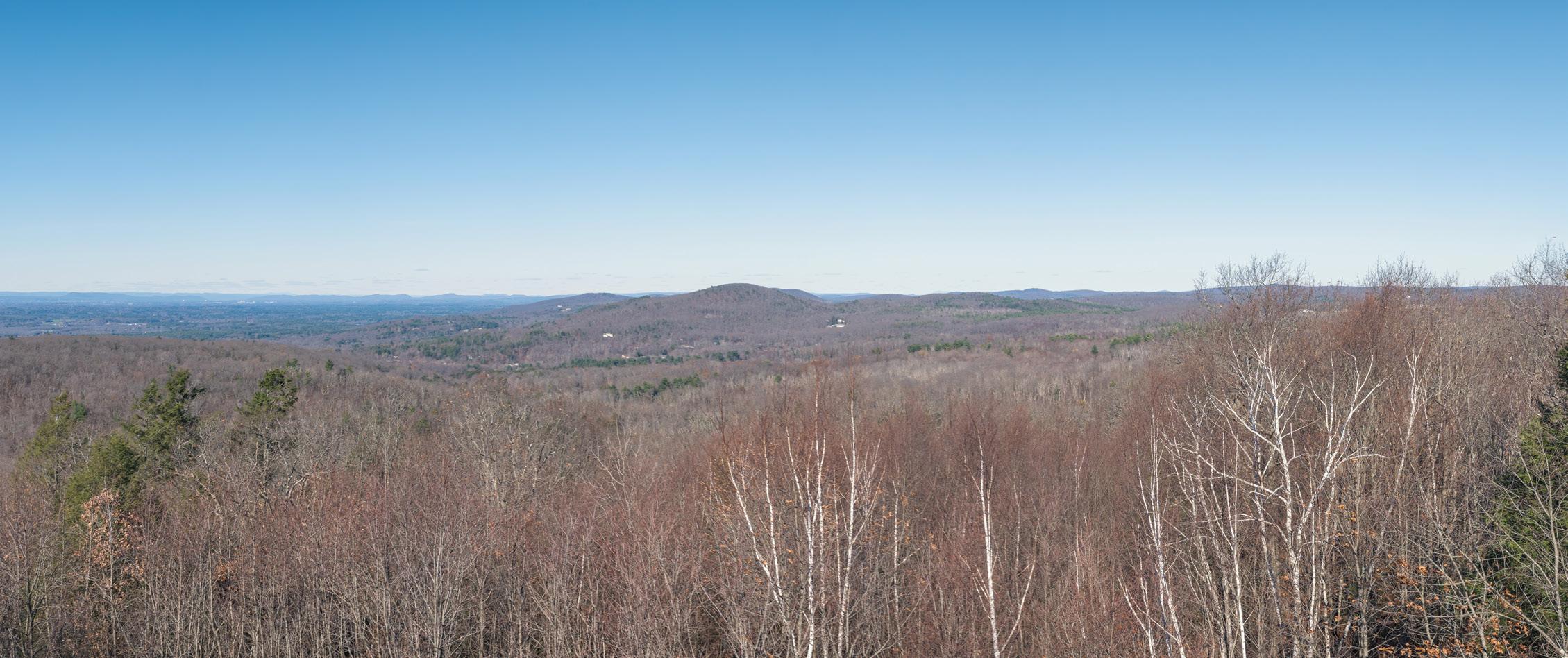
Rock formations and outcrops are found throughout this section. While on the trail, notice the layers or “foliations” in the rock, evidence of its marine sediment origins. This can easily be seen in the outcrop the trail climbs just north of the Parker Road crossing.
The entire trail, from Great Hill Pond in East Hampton to Old Springfield Road in Stafford, runs parallel to the Eastern Border Fault on 450-million-year-old bedrock. The Glastonbury gneiss was formed from a volcanic arc when the small continent of Avalonia collided with North America, closing the 3000-mile-wide Iapetus Ocean, uplifting the crust, and forming the once-Himalayan scale Appalachian Mountains.
East of this fault lies a fracture from which lava erupted to form one of the thickest flows in the world. Soapstone Mountain is thought to have been one of the magma
6 Connecticut Woodlands
roots of these ancient volcanos. The fault was displaced about three miles vertically and is now filled with sediments eroded from the once-30,000-foot mountains to the east. Since this area was a tropical region at that time, the sedimentary rocks in the Connecticut River Valley are red-colored. Today’s Shenipsit Trail would have been about five or six miles under these mountains at the time.
Gradually, these mountains eroded down almost to sea level, but constant regional uplift (like a melting iceberg) and differential erosion, where red sandstone rocks erode faster than hard metamorphic rocks, created the Connecticut River Valley and the Eastern and Western Highlands we see today. Much later, about 15,000 years ago, glaciers scored this landscape, leaving behind rounded hilltops, gravel deposits, and erratic boulders.
I find the contrast between the simple act of hiking this trail and the complex geology of what lies beneath my feet fascinating. I’m humbled by the thought that the closing of a 3000-mile-wide ancient ocean and continents colliding created a volcanic chain, and that its metamorphosed lava remnants are now the gneiss domes over which the trail traverses. To me, this illustrates how short a time we human beings have existed on this Earth. Beats thinking about how many more blowdowns or snow downs we need to clear!
I also like to think that I'm taking care of this trail for the generations to come.

Joe Neafsey is a retired USDA NRCS Water Quality Specialist. He is a proud father and grandfather. Besides travel, he likes landscaping his yard and garden, hiking, biking, and kayaking.
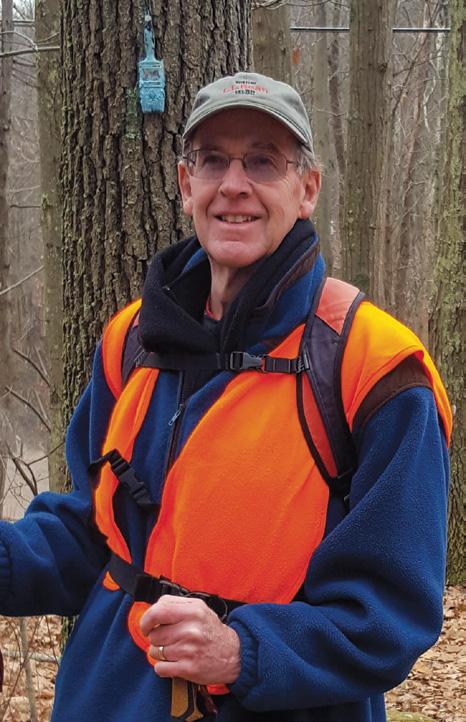
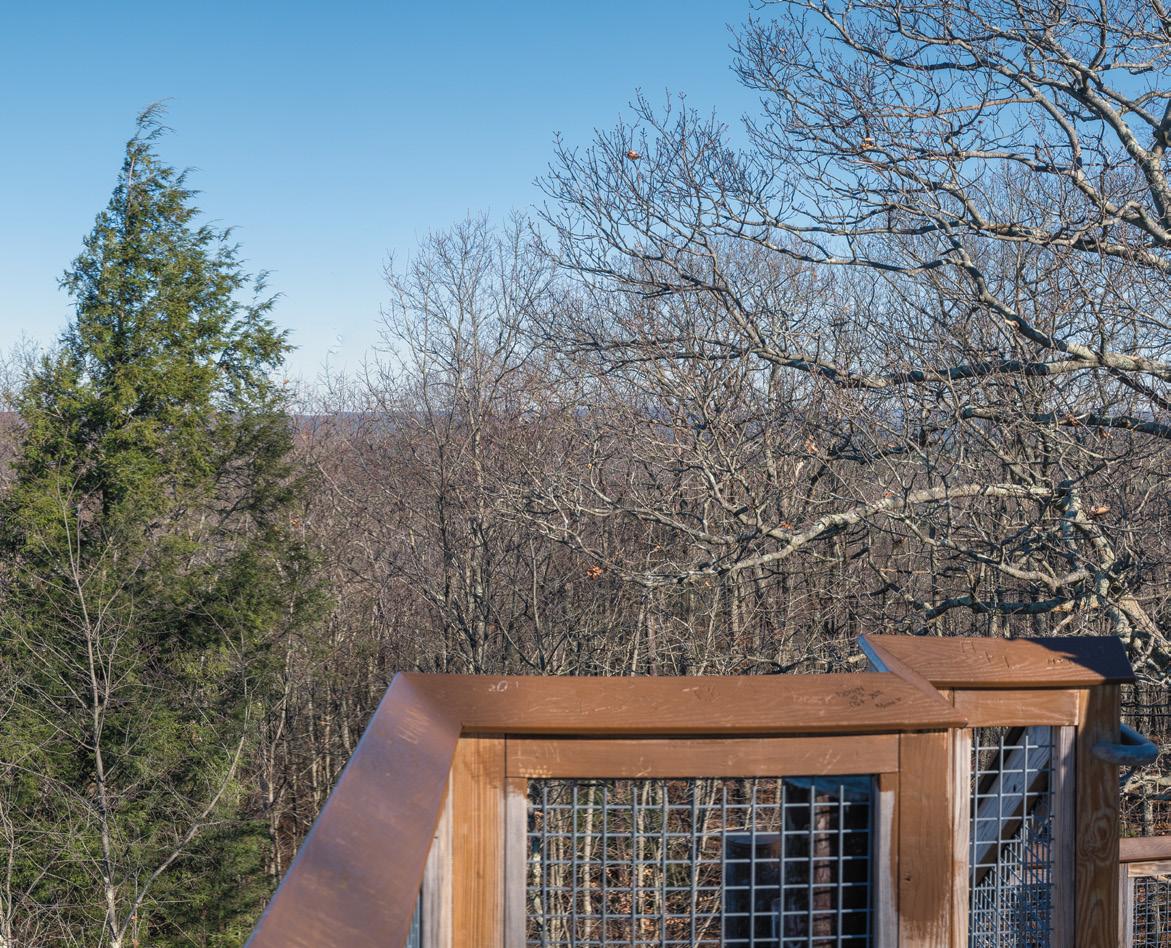 Find the complete map in the Connecticut Walk Book, published by CFPA and Wesleyan University Press.
N
By Timothy Brown
Find the complete map in the Connecticut Walk Book, published by CFPA and Wesleyan University Press.
N
By Timothy Brown
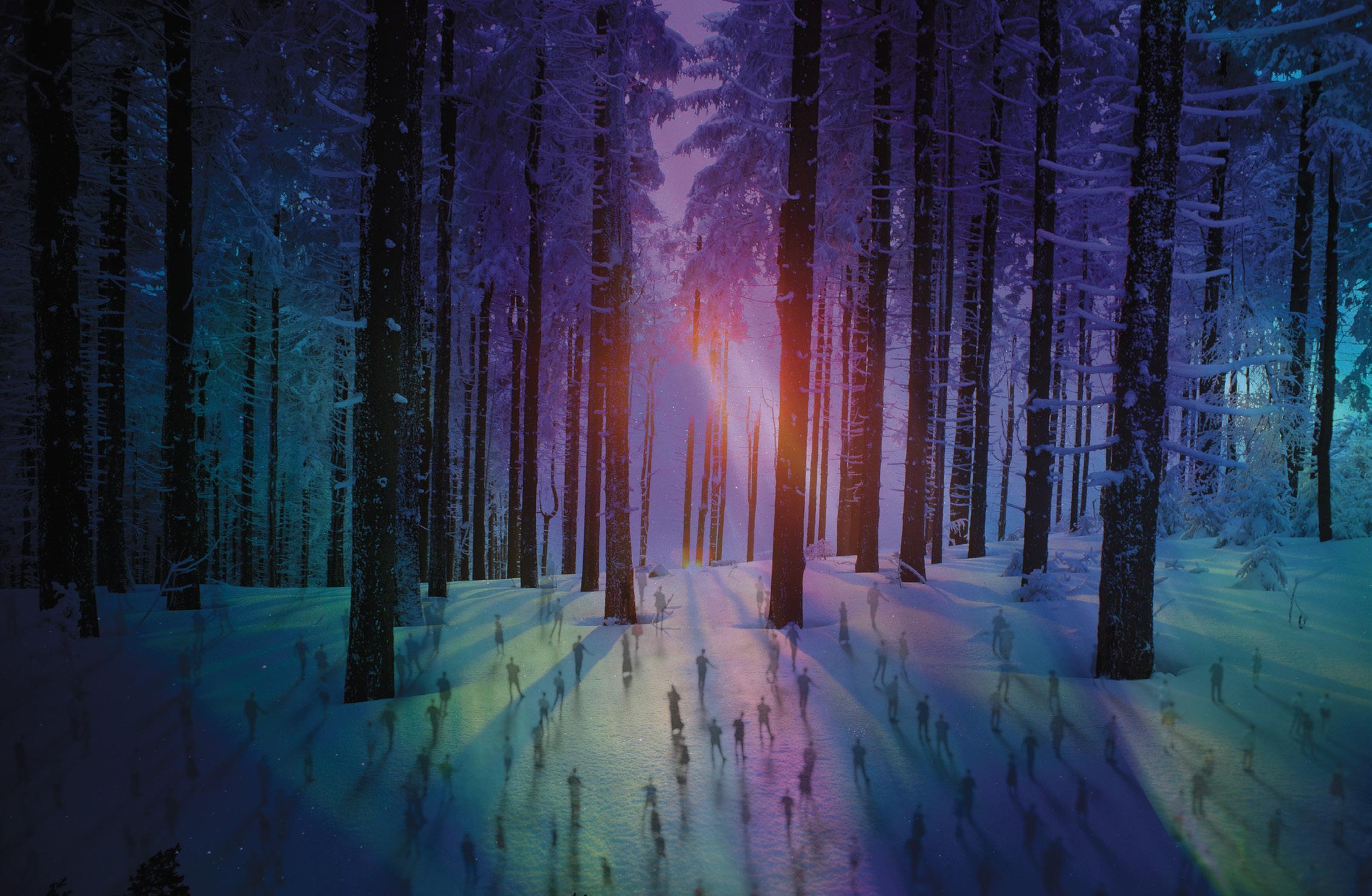
Confronting a Complicated History
n the pre-dawn hours of January 19, 2022, workers at the American Museum of Natural History in Manhattan carefully removed a statue of Theodore Roosevelt riding a horse that had stood for more than eight decades at the entrance of one of the country’s premiere scientific and cultural institutions. The statue, officially called “Equestrian Statue of Theodore Roosevelt, had long been the subject of intense scrutiny due to the portrayal of two shirtless men who flanked Roosevelt’s steed on either side— one Native American, the other of African descent. Highly criticized for its colonial and racist overtones, many viewed the statue not only as a whitewashing of history, but as a reflection of white supremacy itself. Roosevelt is often fondly remembered as the “conservation president.” He was an avid outdoorsman and adventurer, and a passionate defender of the natural world. During his two terms in office, he doubled the number of national parks, and he signed the 1906 Antiquities Act, legislation that Roosevelt used to designate eighteen national monuments, including Devil’s Tower in Wyoming. He also designated 150 national forests, 51 federal bird reserves, and four national game reserves that collectively spanned some 230 million acres across the country. It is undeniable that Roosevelt’s bullish approach to conservation was effective—it safeguarded mountains, canyons, forests, and other natural wonders from industrial development and commercial exploitation. Today, these public lands attract tens of millions of scientists, scholars, and tourists annually from around the world.
But Roosevelt, like all people, was a complicated individual. While he was undeniably committed to conserving iconic landscapes, he was less sympathetic to the rights of Indigenous people who had inhabited these places for millennia. Throughout the West, American Indians were either forcibly removed from their ancestral territories or had their access significantly reduced in order to create national parks and monuments. Some tribes were year-round residents of these lands, while others would access these spaces for hunting, gathering, and sacred ceremonies. In either case, the result was the same: people who had long held deep ties to the land—physically, culturally, and spiritually—were expelled in order to create what some critics have referred to as “playgrounds for the rich.”
In both his writings and speeches, Roosevelt often referred to Indigenous people as “savages” while extolling the virtues of whites over any other race. While it may be troublesome to think of him in this way, Theodore Roosevelt was, to be blunt, racist.
8 Connecticut Woodlands
In order to imagine a brighter future, we must first examine our past.
Roosevelt, however, was far from an outlier in America’s early conservation movement. His friend, Madison Grant, another Manhattan socialite, helped establish the Bronx Zoo, fought for the protection of California’s hardwoods, and advocated for the establishment of national parks across the country. But rather than being remembered as a conservation hero, today Grant is better known for his writings on eugenics—an immoral and unscientific theory that suggests that humans can be “improved” through selective breeding, similar to livestock. Early eugenicists advocated for such appalling practices as forced sterilization and segregation, which they believed would help to “purify” the human race. These beliefs were closely aligned with scientific racism, a gross misinterpretation of Darwin’s theory of evolution by natural selection and Mendelian genetics that promoted the baseless idea that white Europeans are genetically superior to non-whites.
Another early conservation leader, Gifford Pinchot, a Simsbury, Conn., native and German-trained professional forester, helped to establish the U.S. Forest Service, the Society of American Foresters, and the Yale School of Forestry (one of the first in the country), and was highly influential in the early decades of the Connecticut Forestry Association (changed to Connecticut Forest and Park Association in 1928). But Pinchot, who served two terms as governor of Pennsylvania, was also a delegate to the International Eugenics Congress in 1912 and 1921 (the same year he spoke
at the CFA’s annual meeting) and he sat on the advisory council of the American Eugenics Society from 1925 to 1935.
Far from being a fringe movement, eugenicists moved among elite circles in both the U.S. and Europe during the first half of the 20th century. Influential scientists and theologians, politicians and public health officials, and many of the leading psychologists and anthropologists of the day helped to popularize—and normalize—eugenics as a scientific discipline. Perhaps the clearest, most horrific example of the application of eugenics is the Holocaust when Nazis attempted to eliminate Jewish, disabled, and LGBTQ+ people, as well as other ethnic minorities, through ethnic cleansing. It is deeply disturbing, to say the least, to know that America’s conservation movement was once aligned with such a hateful and devastating ideology.
t can be difficult to reconcile the progressive ideals and enduring achievements of early conservationists whose legacies can still be seen not only in the organizations, agencies, and policies they helped to establish, but also in the very land itself, with such misguided notions about people whose histories, cultures, and—simply put—skin color differed from their own. Viewed in one light, our national park system is one of our country’s crowning achievements often described as “America’s best idea.” But the creation of parks, monuments, and other so-called “public” lands also
displaced a key functional component of these ecosystems—the Indigenous people who lived in these places and whose actions helped to shape the landscape. John James Audubon’s paintings are incomparable works of art that give viewers a snapshot into this nation’s biodiversity in the 19th century. But he also owned and sold enslaved people and openly advocated against abolition, both in this country and abroad. John Muir’s impassioned pleas led to the protection of iconic landscapes such as Yosemite National Park. But he also argued against allowing Indigenous communities, such as the Miwok and Mono people who had resided in the Yosemite Valley for thousands of years, the right to continue living, hunting, and gathering within the park’s boundaries. Muir’s vision of wilderness as a place devoid of people is one that continues to dominate conservation discourse and policies to this day. For many BIPOC (Black, Indigenous, People of Color) individuals, the not-so-subtle message over time has been that conservationists care more about animals and trees than they do about people.
Having a deeper understanding of the founders of America’s conservation movement should not lessen their achievements to create parks and protect open space as part of our collective heritage. At CFPA, today’s hope is that this knowledge will help ensure that federal public lands, as well as state-held public lands in Connecticut, actually serve everyone, not just a select and privileged few.
Eric Hammerling
ctwoodlands.org 9
In the 127-year history of CFPA, there’s been a relatively small portion of this history that we’ve been focusing on these issues, but going forward that is changing.
The Work of CFPA’s JEDI Advisory Council
ne measure of how racism, rampant amongst early conservationists, continues to effect and undermine the modern environmental movement is in the lack of diversity of the boards, staff, and membership of environmental organizations. A landmark 2014 study by the watchdog group Green 2.0 of 191 conservation and preservation organizations, 74 government environmental agencies, and 28 environmental grantmaking organizations found that despite making significant improvements in promoting gender diversity within their workforces over the past several decades, ethnic minorities occupied less than 16% of board and staff positions and less than 12% of leadership positions. The report, “The State of Diversity in Environmental Institutions: Mainstream NGOs, Foundations, and Government Agencies,” authored by Dorceta Taylor, currently Senior Associate Dean for Diversity, Equity, and Inclusion and Professor of Environmental Justice at the Yale School of the Environment, served as a major wake-up call for environmental organizations and government agencies who, particularly in light of the current movement for racial justice, are now working hard to develop a more diverse workforce.
For the past five years, Green 2.0 has continued to track the diversity of environmental organizations, who, on the whole, remain majority white. Still, their most recent 2021 report found that people of color now account for over 28% of the workforce in these organizations. And while there is clearly much work to be done, many organizations, including CFPA, are taking concrete steps to acknowledge and address historic injustices, diversify their boards and staff; improve access to the outdoors for people of color, members of the LGBTQ+ community, and other historically marginalized populations; and create a more inclusive community for people from all backgrounds.
“In the 127-year history of CFPA, there’s been a relatively small portion of this history that we’ve been focusing on these issues, but going forward that is changing,” said Eric Hammerling, CFPA’s executive director. Under his leadership, CFPA has established a JEDI Advisory Council (JEDI stands for Justice, Equity, Diversity, and Inclusion) to “incorporate the needs and perspectives of people and communities of color into the design and implementation of CFPA’s inclusive strategic plan, programming, organizational culture, and policy priorities.”
The advisory council, which meets bi-monthly, includes both CFPA board and staff, as well as volunteer community members Marissa Jayawickrema, Jay Levy, Lauren McGregor, Edith Pestana, Marcus Sibley, and Ivelise Velazquez. They advise the Association on issues such as incorporating diversity, equity, and inclusion into CFPA’s ongoing and new work; monitoring the progress and process of equity and diversity in CFPA’s programs and communications; and addressing potential and actual implications from changes to existing or new programs. The council worked with CFPA to craft a JEDI statement affirming CFPA’s commitment to address the social inequities, institutional racism, language discrimination, bias, and other barriers that have historically limited access to the outdoors.
In addition, CFPA has established three internal action planning teams—Decentralizing Whiteness to Build Anti-Racist Culture; Understanding the Needs of BIPOC Communities; and Building an Anti-Racist Workplace— who are identifying key issues and priority recommendations for CFPA’s upcoming 2023 to 2025 strategic plan. Everyone on CFPA’s board and staff is a member of one of the teams.

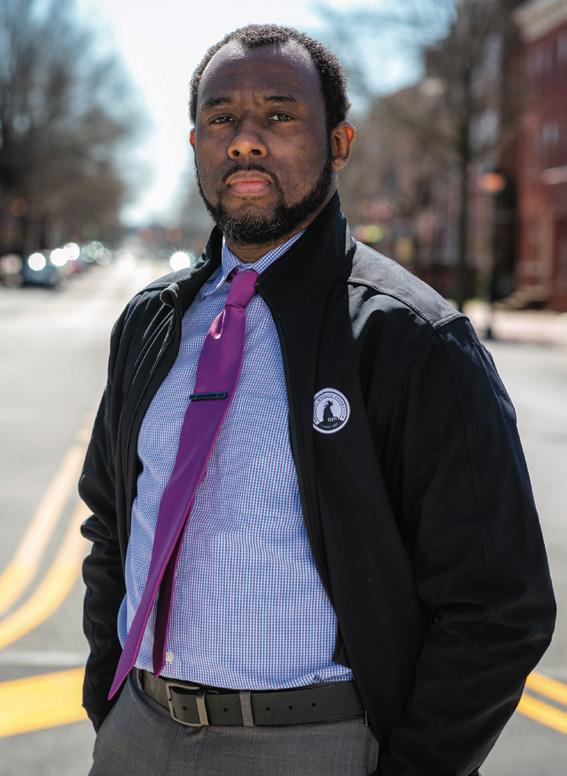

10 Connecticut Woodlands
Edith Pestana
Marcus Sibley
Marissa Jayawickrema
“The next three years are going to be exciting because we’re going to be engaging with many individuals and communities in ways that we never have before, and it opens a lot of potential,” Hammerling said. “We’re not just talking about the need for deeper relationships; we are forming the relationships.”
or JEDI Advisory Council member, Marcus Sibley, building relationships starts with acknowledging the environmental and social justice are two halves of the same coin.
“You cannot remain silent about social justice in one breath and then tell me about the urgency of climate change in the next,” he said during a recent interview. “I don’t believe you. I literally don’t believe you.”
Sibley, who has a background in social work and family therapy, is the National Wildlife Federation’s director of partnerships for New Jersey, New York, and Connecticut. He also chairs the New Jersey Progressive Equitable Energy Coalition and New Jersey’s NAACP State Environmental Committee. “At my core I am an environmental and social justice activist,” he said. “It is my goal to get environmental groups involved in social justice fights because it is my other goal to get social justice groups more involved in environmental fights.”
Justice has been an important theme in both the environmental and climate movements for decades. In 1991, delegates to the First National People of Color Environmental Leadership Summit in Washington, D.C., crafted 17 Principles of Environmental Justice asserting the rights of all people, regardless of race, color, national origin, or income to live in a safe and healthy environment. Two years later, Connecticut became the second state in the nation to draft an environmental justice policy, and in 1994, the then-Department of Environmental Protection (now Department of Energy and Environmental Protection) hired Edith Pestana as Administrator of the state’s Environmental Justice Program.
Pestana, who’s Cuban-American, says it’s not a coincidence that BIPOC and lower-income communities have disproportionately borne the burden of industrial facilities, toxic waste sites, and other forms of environmental pollution. “All of those undesirable facilities are located in the Black communities,” she said. “It was a given, by design.”
In addition to addressing public health crises, one of Pestana’s priorities at the agency has been to connect communities of color with the outdoors through festivals and other public events. In the 1990s, for example, working with local community organizers, she helped to organize festivals at New Haven’s West Rock Ridge State Park, which was underused at the time, particularly by communities of color who live close to the park.
“We started having events there both to get people that used those parks used to seeing people of color in them and to facilitate them feeling comfortable in that park,” she said. “There was just a real movement to get urban youth into green space, into state parks and forests, and hopefully to create the environmental stewards of the future, because you’ll have equity when people see there’s someone who looks like them in those parks.”
“People who have access underestimate the power of just being able to go to a place where you can unwind,” Sibley said. “It is a justice issue when people don’t have adequate, equitable access to forests and parks. And I don’t think we should speak about it in any other way other than a justice issue.”
Marissa Jayawickrema, who began her career as a member of CFPA’s Trail Crew and currently works in cultural resources management for the National Park Service, says lack of representation and access in the outdoors creates an environment that can be hostile to people of color and other marginalized identities.
“It became obvious that trails—both the people who work on them and the people who get to benefit from
them—it’s like a glaringly white demographic, very upper middle class, often laced with a lot of homophobia and misogyny and racism,” she said. “And those are things that a lot of people don’t want to talk about unfortunately.” For Jayawickrema, the daughter of immigrants, the burden of visibility can be draining.
“I’m exhausted being the only queer woman of color in all of these spaces all of the time. And that’s not right,” she said. “It’s never pleasant to show up to a trailhead and have someone question why you’re there with that tone.”
“People are comfortable when they see people who look like them,” Sibley echoed, noting that representation is not only about who is recreating outside, but equally who is staffing these spaces. “How much do you value me if you don’t trust someone like me to work for you?” he said.
The JEDI Advisory Council is a safe space for individuals to share about their personal experiences as they work to craft policies and practices that will guide CFPA far into the future. “It has allowed for people to be able to think about some of their own biases, and everyone has them. It’s about how open your heart is to change,” Pestana said.
“I love the meetings; I love the group,” said Jayawickrema. “The conversations are very elevated on very specific things like transportation and access.”
“Every organization, not just environmental ones, needs to have a JEDI council,” Sibley said, “because white supremacy does not get impacted unless we’re talking about it.”
Learn more at ctwoodlands.org/ about/transparency/jedi/
Timothy Brown is the editor of Connecticut Woodlands.
ctwoodlands.org 11
It is a justice issue when people don’t have adequate, equitable access to forests and parks.
Marcus Sibley
By Hanna Holcomb
Photo by Jaymi Heimbuch
hether you live among forests and farm fields or high-rises and highways, you are likely neig bors with the eastern coyote (Canis latrans var.). These adaptable predators survive and thrive in Connecticut’s rural, suburban, and even urban environments. “They’re in every town in the state,” said Jason Hawley, a wildlife biologist at the Connecticut Department of Energy and Environmental Protection (DEEP). “There’s really no limitation to where they can be.”
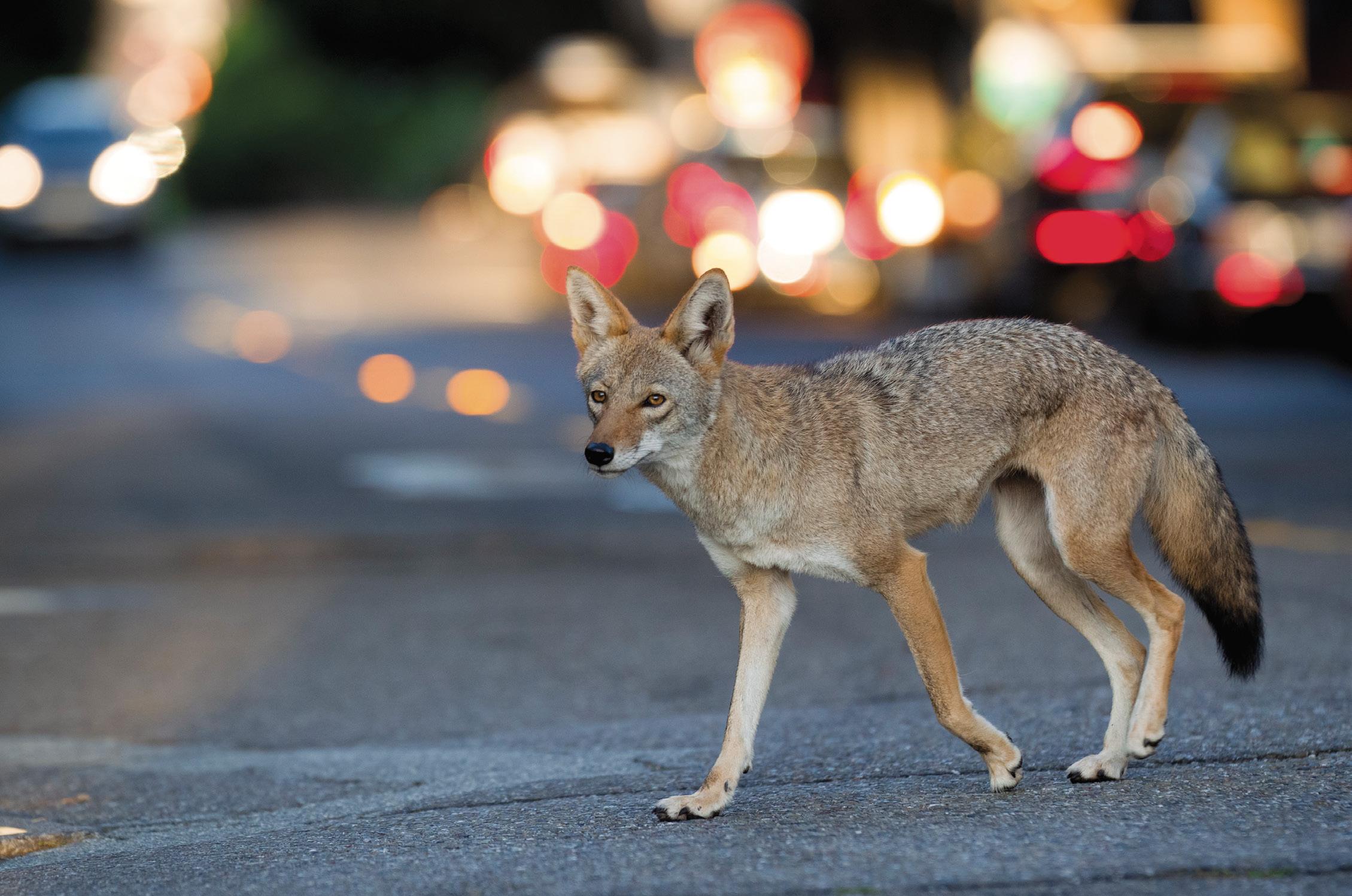
Coyotes didn’t arrive in Connecticut until the 1950s, but DEEP estimates that tens of thousands live in the state today. Though sightings are uncommon, and encounters and conflicts are rare, for some, just the thought of living among coyotes elicits fear. “There’s sort of an aura about them that has been promulgated for a long time that they’re these stealthy, slinking kind of evil characters,” said Paul Colburn, a master wildlife conservationist with DEEP.
Over the past 200 years, few animals have been trapped, hunted, poisoned, and hated with as much intensity as the coyote. Despite attempts to eradicate the species, coyotes have managed to increase both their range and abundance. Today they’re present from Alaska to Panama and have made themselves at home in our major cities.
“They’re here to stay,” Hawley said. “We have to learn to live with them in Connecticut since they’re certainly not going anywhere.”
oyotes have a long history of living near humans. Prior to 1900, they lived in the western two-thirds of the U.S., from Canada to the Yucatan Peninsula. They feature prominently in the stories and mythology of North America’s indigenous peoples. Though depictions vary, coyotes often appear as trickster characters, both good and evil, witty and foolish.
12 Connecticut Woodlands
Despite attempts to eradicate the species, one of North America’s most misunderstood, coyotes are thriving in Connecticut.
“A lot of people say the reason coyotes are here is because we destroyed so much of their habitat, and sometimes that is true. But it also seems that coyotes are kind of choosing to be somewhat close to people.”
Dana Goin, wildlife outreach specialist, Wolf Conservation Center
European colonists, however, viewed coyotes and other predators, such as wolves and mountain lions, as menaces that threatened livestock and hunting stock like deer and elk. Private landowners, as well as state and federal agencies trapped, shot, and poisoned predators with zeal well into the 20th century. In 1931, for example, the federal Animal Damage Control Act appropriated $10 million for coyote eradication. While other large predators became “extirpated” or “locally extinct” due to extermination efforts, coyotes responded by increasing their numbers and seeking new territories.
“They got here in spite of our best efforts to literally eradicate the entire species,” said Chris Nagy, cofounder of the Gotham Coyote Project, which studies New York City’s coyote population and Director of Research and Education at Mianus River Gorge.
Aided by the removal of larger predators, a more open landscape, and their own wit, coyotes began moving east in the early 1900s. To reach New England, they traveled north and crossed paths with dwindling populations of gray wolves in the Great Lakes. Wolves and coyotes are physically able to mate and produce viable offspring, but often avoid doing so. Wolf populations were so low, however, that they reproduced with coyotes out of desperation. As coyotes kept moving east, they also mated with feral dogs and the eastern or Algonquin wolf.
The eastern coyote’s unique genetics has earned them nicknames like “coywolf” and “coydog.” Percentages vary, but one study by Stonybrook University of 462 eastern coyotes revealed a genetic profile of 64% coyote, 13% gray wolf, 13% eastern wolf, and 10% domestic dog. Today, with ample populations for finding mates, there is no evidence of significant interbreeding between coyotes, wolves, and dogs in the United States.
oyotes are helping to fill the role of top predator left vacant when wolves were extirpated from the eastern United States. As omnivores that prey on small mammals and occasionally fawns, coyotes may help keep deer and rodent populations in check. They also eat berries and vegetation. Their adaptability to varied diets and habitats has enabled them to thrive in a variety of environments.
“A lot of people say the reason coyotes are here is because we destroyed so much of their habitat, and sometimes that is true,” said Dana Goin, wildlife outreach specialist at the Wolf Conservation Center in South Salem, N.Y. “But it also seems that coyotes are kind of choosing to be somewhat close to people.”
Though many people perceive urban areas as lacking natural resources, for coyotes they are teeming with opportunity. “Where there are people, there are inevitably rodents,” said
Goin. “There are often a lot of crops or gardens which is going to attract rabbits, and there are lots of squirrels and chipmunks, so there’s going to be a lot of food.”
Studies have shown that urban coyotes maintain smaller territories than rural coyotes, in part because cities can have a higher abundance of resources. In addition, their territory is often defined by the boundaries of the city park or green space that they claim.
Scat analyses have shown that coyotes don’t rely on anthropogenic food sources as much as one might expect. A study of more than 1400 coyote scat samples by the Chicago-based Urban Coyote Project found that their diets primarily consisted of natural prey species like small rodents, white-tailed deer, and eastern cottontails as well as fruit and birds. Human-associated food items were found only at the most-developed sites and made up just 2% to 25% of their diet.
A DNA analysis of coyote scat in NYC by the Gotham Coyote Project found that roughly 60% of samples contained at least one human food item, like bananas. Nonetheless, their diet primarily consisted of mammals like raccoons, rabbits, voles, and deer as well as birds, insects, and plants.
Nagy started monitoring New York City’s coyotes in 2011 by placing camera traps in green spaces in the Bronx. In subsequent years, he watched as coyotes began to colonize more green spaces and other parts of the city.
Tips for Coexisting with Coyotes
n Never intentionally feed coyotes and remove other attractants like pet food, garbage, and bird feed
n Keep pets under your supervision— keep cats indoors, particularly at night, and dogs on a leash
n Close off crawl spaces under decks and buildings to prevent coyotes from denning there
n Attempt to scare away coyotes by yelling or using an airhorn
n Report abnormal or unusually bold behavior to the DEEP Wildlife Division and your local Animal Control Officer
“You see a leapfrog progression year to year, and it happened pretty fast across the Bronx,” said Nagy. “Most of the green spaces with some amount of forest in them now have coyotes.”
Colonizing new green spaces, however, is no small feat. Coyotes live in family units and the two parents, who mate for life, defend a territory where they raise their pups. Typically, pups are born in mid-March to early April. By October to December, some pups strike out to find their own territory and mate, while others stick around with
ctwoodlands.org 13
mom and dad to help raise the next litter. Without a map to guide them, the coyotes that leave have to contend with highways, waterbodies, and other hazards in hopes of stumbling upon suitable habitat. “It’s risky for these animals to leave the place they were born,” said Nagy. “And they sort of have to do it if they want to reproduce.”
Despite living in close proximity to people, coyotes still work to avoid us. For the most part, they are crepuscular, meaning they are most active at dawn and dusk. However, in urban areas, coyotes are more nocturnal to avoid interacting with people.
am Lewis is a wildlife biologist who uses game cameras to study eastern coyotes at the McLean Game Refuge in Granby, Conn. She found that on the eastern half of the refuge, which has more trails and is closer to Granby’s town center, coyotes frequently use the trail system, but almost always at night.
“They’re still relatively skittish around people,” said Lewis. “For the most part when we’re hiking in the woods, we’re maybe talking, or we’re stomping, or we have a pet with us that’s making noise, so they generally will hear us before we even notice them and try to get away.”
While coyotes want to avoid us, urban coyotes have to be more tolerant to human presence than their rural counterparts. “If you go out in the wilderness with a coyote or fox (and) get within 50 yards or 100 yards, they’re just going to run away. That’s it’s comfort zone,” said Nagy. “But if that was the case for animals in New York City then they would just be running away 24/7. There’s always a person.”
Coyotes, he explained, have to become habituated to human presence and sounds, such as lawn mowers and vehicles. The problem, however, is when they become conditioned.
Conditioned coyotes have likely been fed by people and start to seek out interactions and food rewards. They may exhibit bolder behavior which can lead to bites and attacks. According to data from DEEP, there were 69 coyote “conflicts” in 2021. Conflicts vary in severity, however, from people simply being upset that there are coyotes in their yard to aggressive behavior towards pets and people. Since April 2022, DEEP has issued three permits to Nuisance Wildlife Control Operators to remove problem coyotes. Such permits are only issued when coyotes are directly causing problems, often attacking dogs.

In addition, Connecticut allows coyote hunting year-round and trapping for about five months of the year, both without bag limits. Nationwide, about half a million coyotes are killed every year as a means to remove “problem” animals and “control the population.” Ironically, indiscriminate coyote removal can lead to a larger population.
“Coyotes are density dependent breeders,” said Lewis. “When there’s a mated pair that defends a territory and one or both of the coyotes are killed, the other ones in the area are just going to breed more now that there’s more territory and more resources for them and their kin.”
reventing conflicts and understanding why conflicts occur, rather than simply removing coyotes, can promote better coexistence. Goin offers a program through the Wolf Conservation Center to create “Coyote Wise” communities. The program teaches local officials and residents about coyote behavior and ecology and how to prevent conflicts. The goal is to help people feel safer while recreating outdoors, and to promote coexistence. “I love talking about coyotes, but I also love knowing that we’re making people more comfortable and making coyotes a little bit safer as well,” said Goin.
Southbury is currently the only Coyote Wise community in Connecticut. Animal Control Officer Melody Sandquist said offering Coyote Wise programming has helped residents become more comfortable living with coyotes.
“People have come up to me and said, ‘I understand more about coyotes now and I don’t have to be petrified,’” explained Sandquist. “I definitely think the programs have been successful in mitigating some of that fear that people have.”
14 Connecticut Woodlands
“They’re here to stay. We have to learn to live with them in Connecticut since they’re certainly not going anywhere.”
Josh Hawley, wildlife biologist, CT DEEP
Camera traps are an indispensable tool for conservationists. When an animal crosses an infrared sensor, it triggers a digital camera to take a photo or video. This eastern coyote was photographed by a camera trap at the McLean Game Refuge. Photo courtesy of Sam Lewis.
Though coyote conflicts are rare, they often increase during the breeding and pup rearing season, from January to mid-summer, especially when a hiker or walker has a dog. “The coyote sort of views the dog as just another coyote that’s infringing on their territory and is a potential threat to their family groups, particularly their pups,” said Hawley.
Rather than being scared off when a hiker is on the trail, coyotes may be more likely to stand their ground, or even follow people to get them away from a den site, which can be frightening. “What they do sometimes is called “escorting.” If they have a den nearby, especially if they have pups, and you’re walking near it, they might follow you to make sure that you’re getting away,” said Lewis. The best thing to do is turn around, go the way you came, and avoid the denning area until about July.
Conflicts can occur when residents intentionally or unintentionally leave out food rewards like garbage and dog food. Bird feeders can attract coyotes to residential areas as well. “They don’t necessarily eat the seed, but they are attracted to the small rodents and mammals that may be under the feeder,” said Colburn. Removing these attractants can reduce the amount of time coyotes spend near people.
Coyotes do also occasionally attack and kill small pets like small unleased dogs and cats but keeping these animals inside or leashed helps protect them. Residents can also help reinforce coyotes’ natural fear of people through hazing. Making loud noises by yelling, banging pots and pans, or using an air horn can scare them off.
“Hazing them reinforces that people are unpredictable, loud, and kind of frightening, because that’s what they normally think,” said Goin. “But sometimes they unlearn that fear if we’re not giving them reason to believe it.”
Coyotes are perhaps the most adaptable animal in the world, able to exploit nearly any habitat, from farm field to city park. Though they live comfortably among people, we are less comfortable with them. Misconceptions and fears often obscure their true nature as a resilient, shy, and opportunistic predator. But people and coyotes can safely coexist. With a few simple changes, we can adapt to the coyotes’ presence, just as they’ve adapted to ours.
Hanna Holcomb, a native of Woodstock, Conn., is a freelance writer and naturalist living in Idaho.

ctwoodlands.org 15
Advancing Conservation One Image at a Time: A
Conversation with Jaymi Heimbuch
Jaymi Heimbuch is a conservation photographer, naturalist, and instructor who has traveled the globe in search of stories about the natural world. She is the founder of the Urban Coyote Initiative, the host of “Impact,” a conservation photography podcast, and the author of “The Ethiopian Wolf: Hope at the Edge of Extinction.” Her photographs have appeared in National Geographic, Audubon Magazine, and other outlets. We caught up with Jaymi to learn more about her work. This interview has been edited for clarity and length.
Connecticut Woodlands: What drew you to conservation photography?
Jaymi Heimbuch: After I got into photography and was taking all of these images, it just didn’t feel right for me to be collecting images without them doing anything. With conservation photography it’s a clear path, a way for you to put your images to work for the things that you love taking pictures of, whether it’s a species, a place, or just wilderness in general. It gives any photographer a way to feel empowered to do something for climate (and) the environment.
What made you interested in photographing urban coyotes?
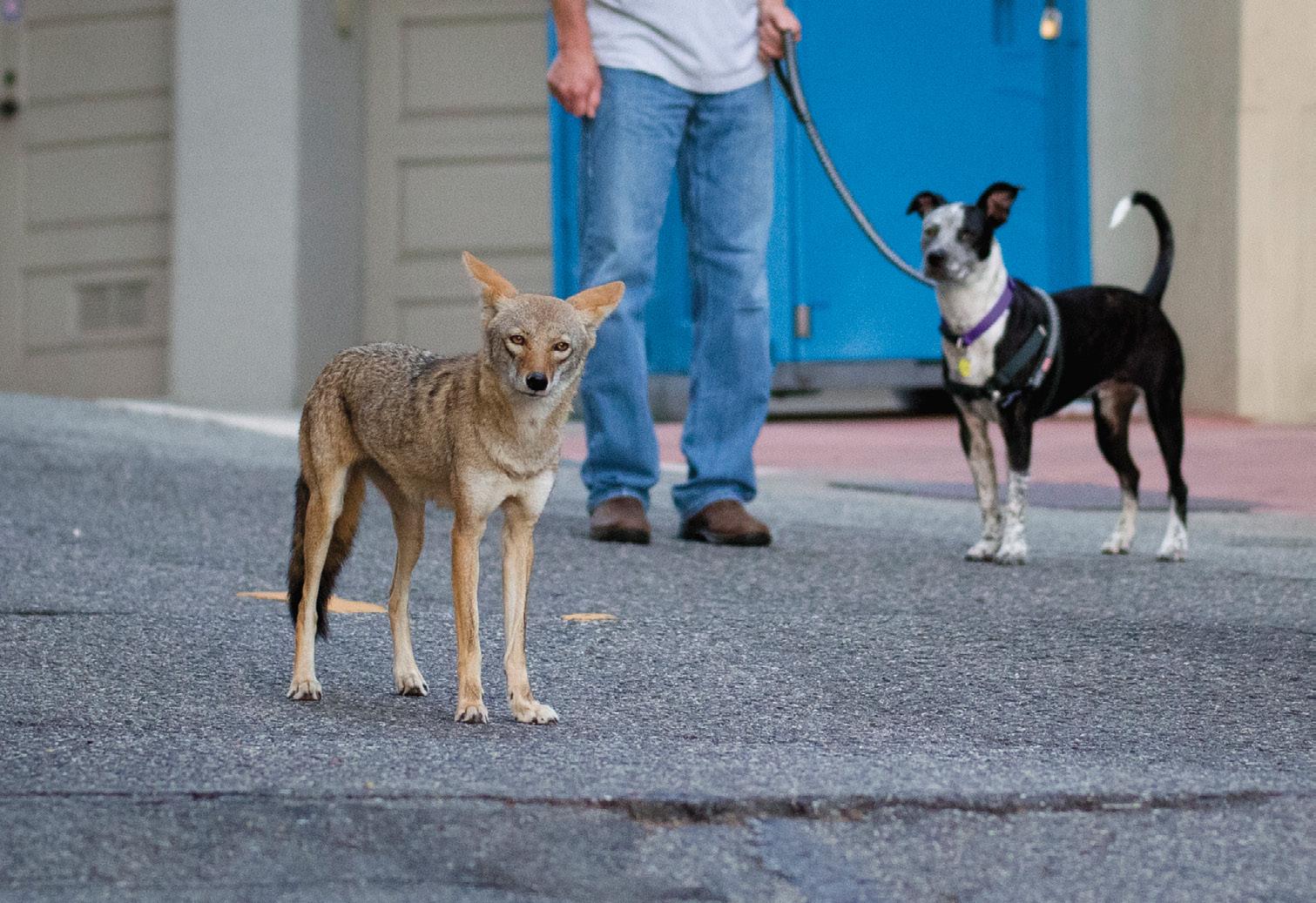
JH: One night I was walking my dog in San Francisco and a coyote ran past us down the middle of the road. I thought it was amazing that this rather large canid can make a living and thrive in such a densely urban place. They are so adaptable, and they force us to think about wildlife in urban spaces. Because coyotes are such a controversial species, they also bring out elements of ourselves and what we think about nature. For example, if we hate coyotes being here, why is
that? What makes us afraid? And what does that mean for our connection to nature and living alongside wildlife?
Coyotes are often elusive. How do you get such intimate shots of these animals?
JH: In San Francisco there were coyotes in certain areas that were a lot more habituated to people, kind of out of necessity in a lot of ways. Most people weren’t seeing coyotes daily, but in particular areas of the city, if you understood their habits, it was pretty easy to find them. It really was a matter of paying attention to Facebook groups or places like nextdoor.com for where people were seeing them and then going out when coyotes were likely to be active and there was enough light to photograph them.
Talk about the story behind the image of the coyote and the dog walker. JH: This coyote was in one area where a lot of people would come and walk their dogs, and she was getting pretty bold. A lot of times she was just curious about them and would follow them around and see what they were up to and where they were going without a whole lot of interaction. She was just monitoring them in a way. I wanted to
have shots that show that coyotes can be nearby and curious without necessarily being threatening. It’s tough though, because at the same time you also want to be clear that we have to maintain a coyote’s fear of people and dogs because that keeps everybody, including the coyote, safer. What’s one piece of advice you have for aspiring conservation photographers?
JH: My biggest piece of advice is to look for an idea or a project that’s near home. The urban coyote project started outside my front door, and even though it expanded later, I could have done so much in just my city. Look for what you want to work on that’s local because it gives you access on an ongoing basis. You also get to build so many connections in your own area that could open up opportunities or more projects in the future. It also helps you see the difference that you’re making in your own community, and that can be really invigorating and revitalizing. Some of the best, most engaging, crazy stories out there are happening in our own towns. We just have to get out there.
16 Connecticut Woodlands
While coyotes tend to be more curious than threatening, keeping dogs leashed can help reduce conflicts. Photo by Jaymi Heimbuch.
Heavenly Blue Carol Chaput

Here, again, snow, a blank stillness sifting over fallow fields, over dark woods.
I think of red and yellow, of absorption, spectrums, the milky glacial blue of ice curling beneath the white canyons of winter, of big white bears pawing over ridges and moraines, leaving behind them bright blue trails, breaking open with light.
Here is Thoreau stepping deliberately through the snow in his own tracks.
… they were filled, he wrote, with heaven’s own blue.
I walk into the bright shimmer, hunched before the sharp smack of cold and wind scoured, into the ravishing indifferent drifts.
Following me, petals, the bold blue of morning glories.
Carol Chaput's poems have appeared in numerous collections, including “Waking Up to the Earth, Connecticut Poets in a Time of Global Climate Crisis." She was recipient of the 2020 Nutmeg Poetry Award from The Connecticut Poetry Society. A collection of her poems, “Field Notes,” was published by Dogwood Press.
ctwoodlands.org 17
ne sunny day in late winter, Dennis Quinn will get the urge to don a wetsuit and snorkel gear and jump into an ice-cold stream. There might be patches of snow on the ground. The air temperature will be in the upper 30s, the water temperature around 35. He’ll be looking for a quirky turtle that doesn’t spend the winter buried in mud at the bottom of a frozen lake or pond, but instead lazes about at the edge of a flowing river or mid-sized stream. He will reach into a tangle of roots and leaf litter and lift out a sleepy eight-inch wood turtle. Then he will set about taking measurements and using a small file to make a notch in the edge of the turtle’s shell.
Wood turtles enter a clean, fast-flowing stream in October and tuck up against an undercut bank, usually in a root tangle, log jam, or deep pool.
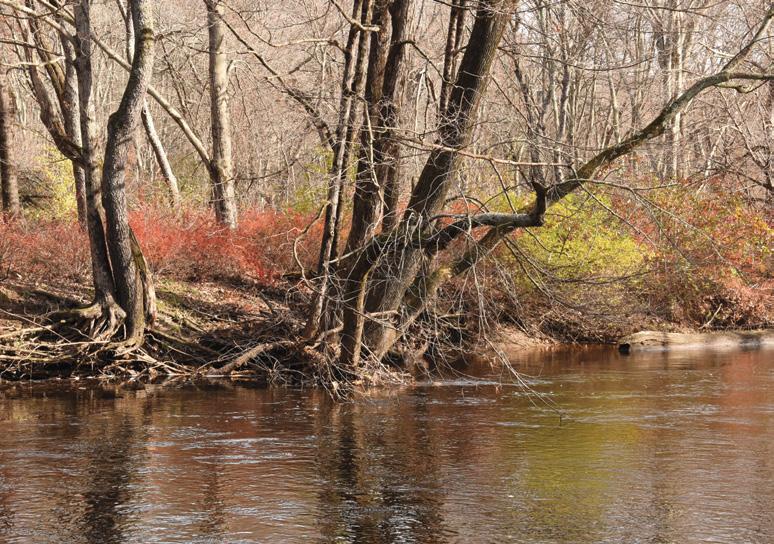
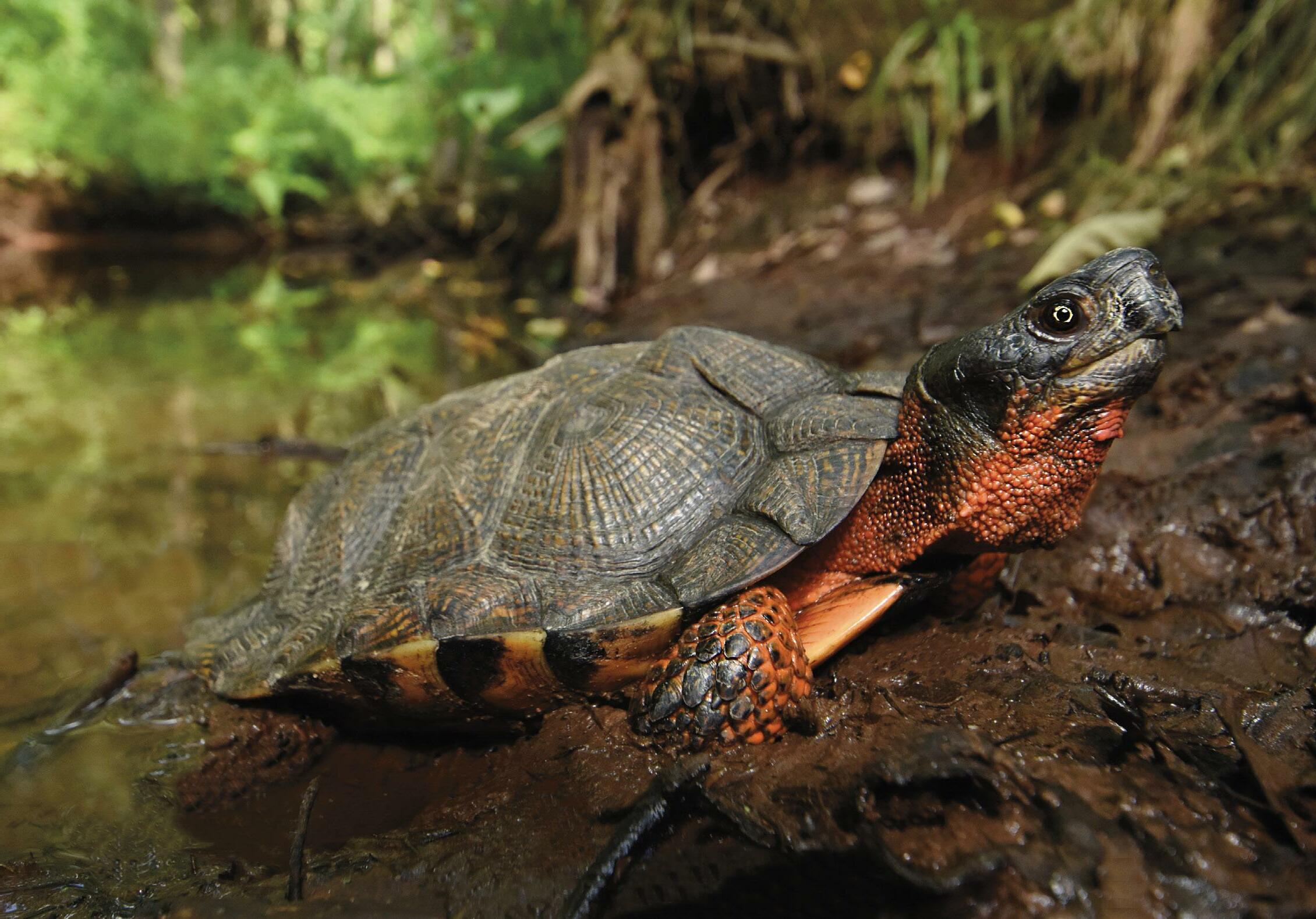
The wood turtle is a medium-sized turtle with a carapace that looks like it was crafted in an artist’s studio. Its scientific name, Glyptemys insculpta, refers to the sculpted appearance of its scutes, the segments of its top shell. Each scute has faint yellow growth rings radiating from its center, created by tannins and minerals that accumulate in the grooves. Orange, red, and pale-yellow pigments color the turtle’s throat and the undersides of its legs, contrasting with its dark brown or black shell.
Quinn, a consulting herpetologist for the Connecticut Department of Energy and Environmental Protection, is among the biologists monitoring wood turtles, which have become increasingly rare. Turtles are on the decline here and elsewhere, due in large part to urbanization. Of the state’s 12 native species—including sea turtles—nine are endangered, threatened, or of special concern. The state’s rarest is the tiny bog turtle, which has been on the federally endangered list since 1997.
18 Connecticut Woodlands
Along with the box turtle, spotted turtle, and diamondback terrapin (a brackish water species), the wood turtle is a state species of special concern.

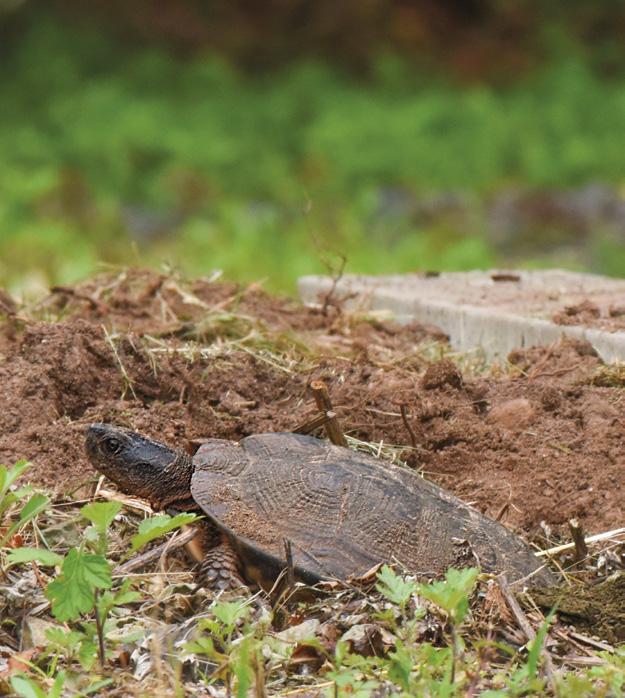
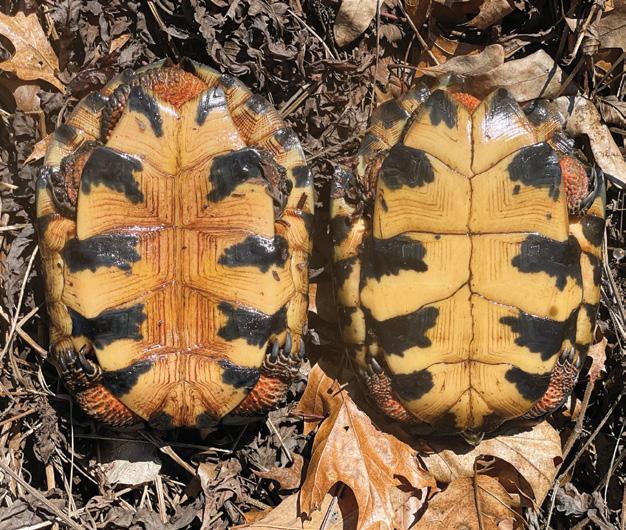
“The wood turtle population is not as stable as it once was,” Quinn says. “There are still plenty of streams that have them, but we worry about their sustainability in the long term. No streams in Connecticut harbor the number we would have seen historically.” He cites the Mill River in Hamden: “It used to be a big wood turtle spot. Now, they’re all gone.”
Urbanization is the greatest threat. The wood turtle’s linear habitat consists of a river corridor and adjacent wetlands, woods, and fields, usually within 1,000 feet of the water. It spends the early spring, fall, and winter in its aquatic habitat, moving upland in summer. When development fragments their habitat, wood turtles are isolated from one another and cannot complete their life cycle.
Besides habitat loss and fragmentation, road mortality is a serious threat. When they leave the water to forage for food or search for mates, or to dig their nests in sandy soil, turtles are hit by cars and agricultural vehicles. Females may spend several days testing out sites, crossing roads in the process.
The other big threat is illegal collection, incidental and deliberate for the international black market. Even innocent collection can be harmful. Many people can’t resist the urge to bring a turtle home, at least for a while. Even if they return it to the wild, they may not return it to the location where it was found, and the turtle may lack the habitat it needs to survive.
Ironically, Quinn points out, public access to greenways in wetlands presents a threat to some wildlife populations by bringing paved paths, people, dogs, and the introduction of non-native species. “The impact of a path goes much further than those 10 feet,” he says. “It goes hundreds of feet beyond that.”
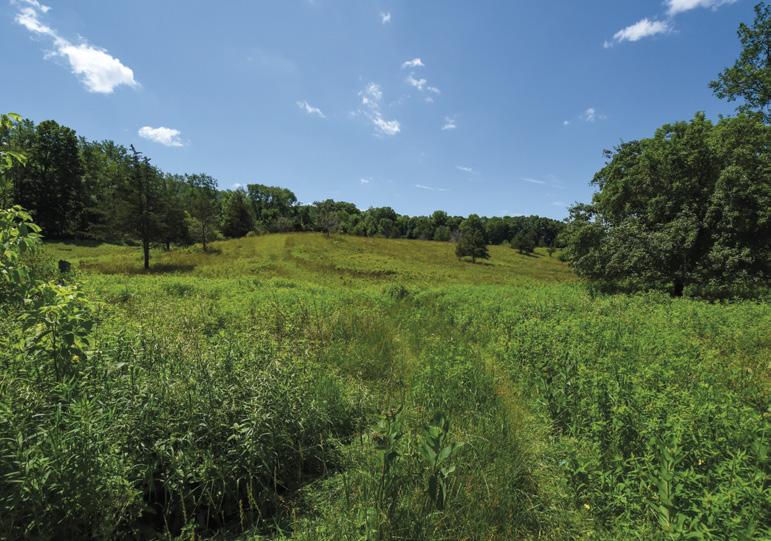
It is the turtle’s life history that makes it so vulnerable to depletion. “The removal of a single adult can significantly affect a population,” explains Hank Gruner, a Connecticut herpetologist with more than 30 years’ experience. “Their whole evolutionary strategy is to live a long time and reproduce. It takes wood turtles more than a decade to reach sexual maturity, after which they lay up to 12 eggs every year, to an age of as much as 75.”
A small percentage of those offspring survive, however, as eggs and hatchlings are preyed on by everything from ravens to hungry fish. Gruner contrasts these survival challenges with those of a garter snake: “They reach maturity in two years, skip the egg stage, and have 20 to 40 live babies. Even with a lot of road kill, they make up for it with successful reproduction.”
When the weather gets cold, turtles begin hibernation. In cold-blooded animals, hibernation is called brumation, a period during which their body temperature, activity, heartbeat, and respiration drop but they still occasionally move about.
Wood turtles enter a clean, fast-flowing stream in October and tuck up against an undercut bank where the flow is lower, usually in a root tangle, log jam, or deep pool. They survive in open water just above freezing thanks to an evolutionary adaptation called cloacal respiration. Unlike snappers and painted turtles, which winter safely in mud under the ice, wood turtles need constant access to oxygen during brumation. Because their winter metabolism is so low—roughly five percent of what it is in summer—they extract enough oxygen for their needs from the water, mainly through the cloaca, the opening at the end of the digestive system. Biologists, especially when addressing groups of schoolchildren, often use the term “butt breathing.”
This process only works if there is enough oxygen in the water, Quinn says, which is why protection of healthy
From the top: A wood turtle nests in a suburban area.
Wood turtles spend the winter in a state of brumation when their temperature, activity, heartbeat, and respiration drop.
The plastron, or underside, of male and female shells.
Wood turtles prefer to forage in early successional habitat.
ctwoodlands.org 19
A hatchling wood turtle faces many challenges, from predators to vehicles to urbanization. Only a small percentage of wood turtles survive to adulthood.

buffers along rivers is so critical to turtle conservation efforts. One example of human-caused danger is a winter gravel operation that changes the water level, exposing hibernating wood turtles and causing them to freeze.
If you ask a biologist exactly where to find wood turtles, you probably won’t get a straight answer. They are more comfortable telling you where you aren’t likely to find them. This way, they can highlight the species’ special habitat needs, and ways to ensure that those areas are protected. So don’t ask—just be glad when you find one. It’s a red-letter turtle day.
Updates CFPA
Laurie D. Morrissey is a New Hampshire-based writer of articles, essays, and poetry. Her work has appeared in Connecticut Woodlands since 2016, when she wrote about her father, Connecticut state park
ranger Bill Dougal. Her writing has appeared in Northern Woodlands, Art New England, New Hampshire Home, Appalachia, and numerous poetry journals.
Master Naturalist Program Now Accepting Applications

Are you interested in learning more about the natural world and promoting awareness, stewardship, and respect of the environment? The James L. Goodwin Master Naturalist Program is a dynamic 12-month course that teaches about Connecticut’s unique habitats, flora, and fauna through a combination of classroom presentations and outdoor, hands-on field sessions. Participants learn about Connecticut’s environment using science-based information and interpretive techniques that prepare participants to share their knowledge with others and foster principles of connectivity, biodiversity, and conservation. The next cohort begins Spring 2023. Learn more about the program and apply at ctwoodlands.org
CFPA Volunteers Recognized for their Trail Work
CFPA’s Annual Meeting and Volunteer Appreciation Dinner in November, Ralph Scarpino, Helen Ann Landgraf, and Erik Landgraf (pictured above) were recognized with the Golden Gloves Award for their exceptional contributions to our trails program. Their leadership at American Legion and Peoples State Forest has resulted in the construction of a boardwalk and overlook platform out into Beaver Brook Marsh and a winding elevated walkway through a red maple swamp. They have also worked with and mentored our Summer Trail Crew during the development of a multi-year stone turnpike project. Ralph, Helen Ann, and Erik are an exceptional team and we are so grateful for their great work!
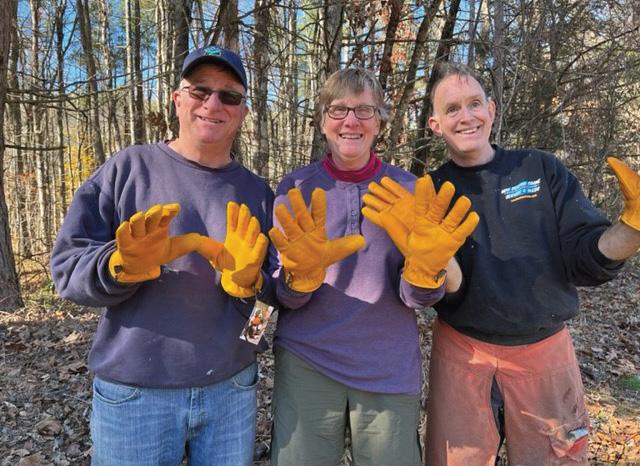
20 Connecticut Woodlands
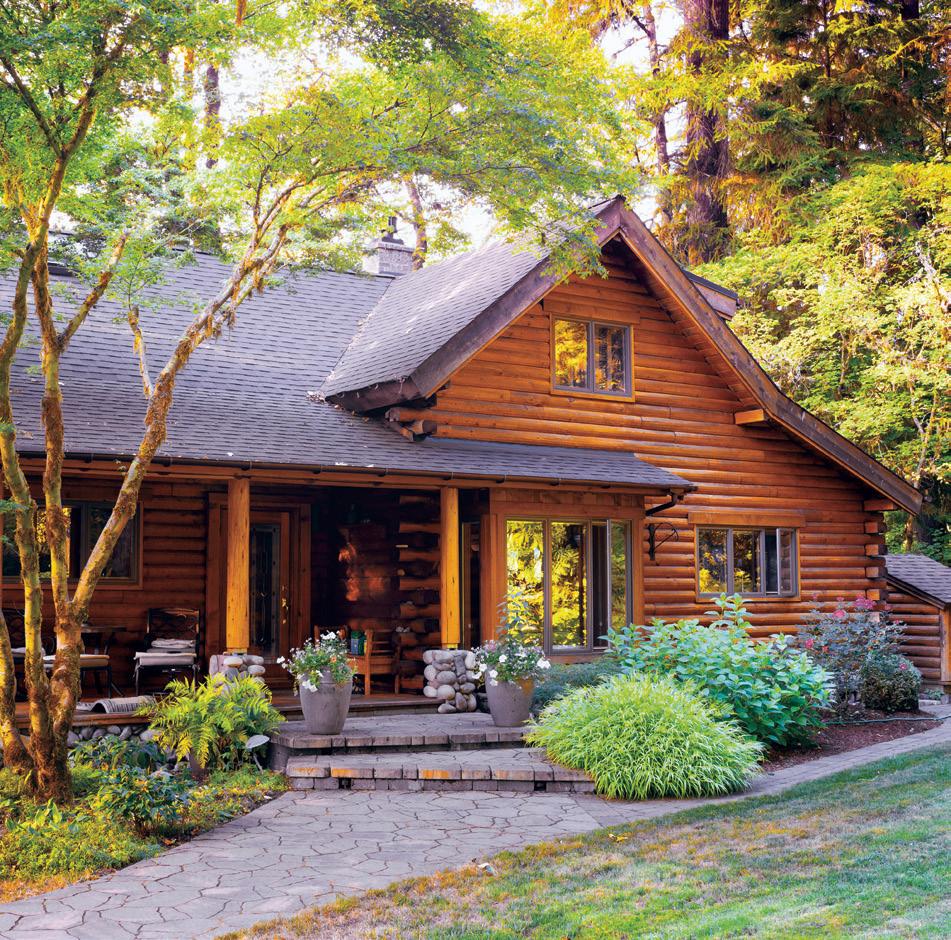




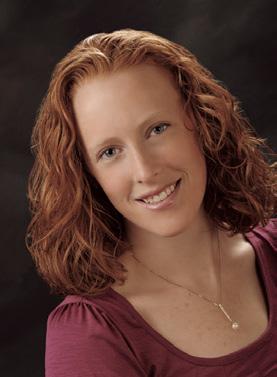
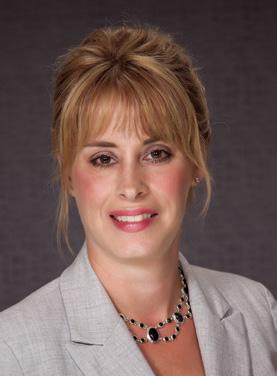
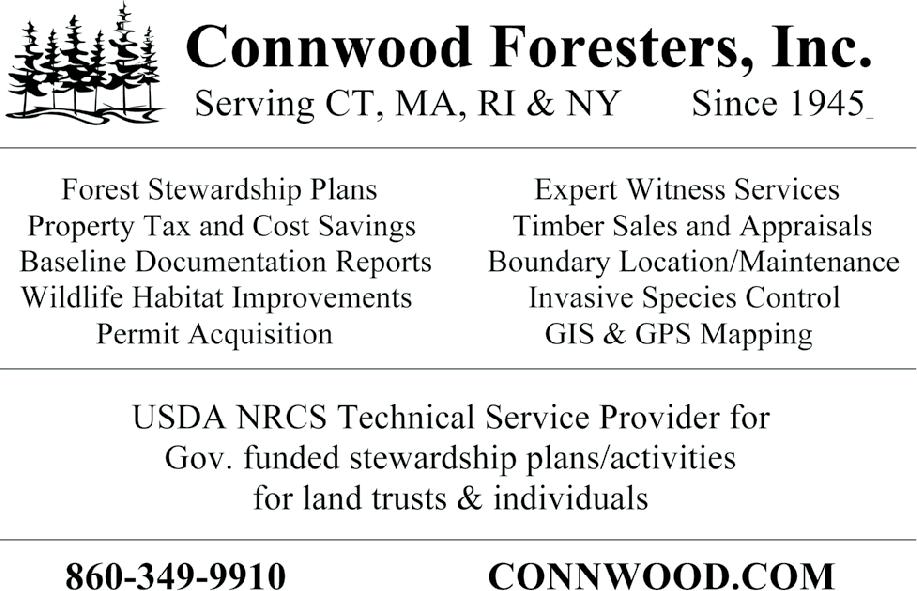

LOANS FOR BUILDING A COUNTRY LIFE HOMES • HOME CONSTRUCTION LAND • TIMBERLAND Breezeway. Farm Credit East NMLS No. 522993 CountryLivingLoans.com Heather Allen MLO NMLS No. 550995 78 Hartford Pike, Dayville, CT 800.327.6785 Heather.Allen@CountryLivingLoans.com Sandra Pearson MLO NMLS No. 255034 240 South Rd., Enfield, CT 800-562-2235 x8177 Cell 413-348-4210 Sandra.Pearson@CountryLivingLoans.com ctwoodlands.org 21 Give the Gift of Belonging! Membership at CFPA is about being included. Whether it’s an education program, a trail work party, or just hiking with a group of friends, YOU create the CFPA community. Invite your friends to join in on the fun by becoming a member, or better yet, give them the gift of membership. Join, renew, or give a membership at www. ctwoodlands.org/join
Ferrucci & Walicki, LLC Land Management Consultants
Environmental Stewardship and Land Management since 1982
• Forest & Open Space Management Services
• Property Tax Reduction (PA 490 & Chapter 61)
• GIS Mapping

• Forest & Wildlife Habitat Improvement
• Timber Inventories & Appraisals
• Professionally Managed Timber Harvests
• Environmental Oversight
• Watershed & Utility Land Management
• Recreation Plans & Implementation
• Forest Stewardship Plans


6 WAY ROAD
MIDDLEFIELD, CT 06455 860-349-7007 FAX: 860-349-7032
EMAIL: FW@FWFORESTERS COM WWW.FWFORESTERS.COM
Satellite Offices in Connecticut: HAMDEN, NEW BRITAIN
Forestry Staff: ERIC HANSEN, CT CERTIFIED FORESTER F-720 TOM MCGRADE, CT CERTIFIED FORESTER F-1314

22 Connecticut Woodlands Purchasing Standing Timber. www.hullforest.com Wills, Trusts, Estate Planning and Elder Law Succession Planning, Conservation Easements and Charitable Giving, Representation of Executors and Administrators – – –Attorney Norbert W. Church, Jr. 250 W. Main St., Branford, Connecticut 06405 203-488-0300 churchandchurch@yahoo.com at-home, telephone, or Zoom consultations Celebrating over 40 years of practice in Connecticut
Pathways
In October 1853, the Reverend Horace Bushnell, pastor at Hartford’s North Congregational Church (now Immanuel Congregational) and one of America’s leading theologians, stood before the 29-member Hartford City Council with a novel proposal—to establish a municipal park in the heart of downtown. His was a radical idea, not simply because the location for his proposed park at the time was home to factories, tanneries, crowded tenements, and a heavily polluted river, but because Bushnell believed the park should be created using public, not private, funds.
In the mid-19th century, cities across the country were rapidly expanding (Hartford’s population would double between 1850 and 1860) driven by manufacturing, printing, textiles, banking, and other industries. But poor sanitation, pollution, and other public health crises accompanied this economic boom. Civic leaders began to advocate for urban parks as a respite from the ill-effects of industrialization. Private investors contributed funds for parks, including in New York City, where land was already being purchased for what would become Central Park.
But after hearing Bushnell’s hour-long presentation, the City Council voted unanimously to allocate $105,000—over $4 million today—to purchase 40 acres to create the park. And in January 1854, Hartford voters approved the measure by nearly a 3 to 1 margin, making it the first publicly funded park in the nation.
It took several years for the City to acquire the land for the park. Finally, in 1860, recognizing the need for a comprehensive plan, Bushnell called on his lifelong friend and Hartford native, Frederick Law Olmstead, to design the park. But Olmstead was busy designing Central Park and recommended Jacob Weidenmann, a Swiss-born landscape architect and botanist, for the job. Weidenmann selected 157 varieties of trees and shrubs—1,100 individual specimens—to be planted in natural settings, a divergence from the more formal New England town greens of the day. Today Bushnell Park still provides space for people of all backgrounds to come together for concerts, festivals, cultural events, and much-needed respite from the harried pace of city life.
[Bird’s-eye view of Hartford, Connecticut, from Capitol, after snowfall] [graphic]. c1916. U.S. GEOG FILEConnecticut-Hartford [item]

ctwoodlands.org 23
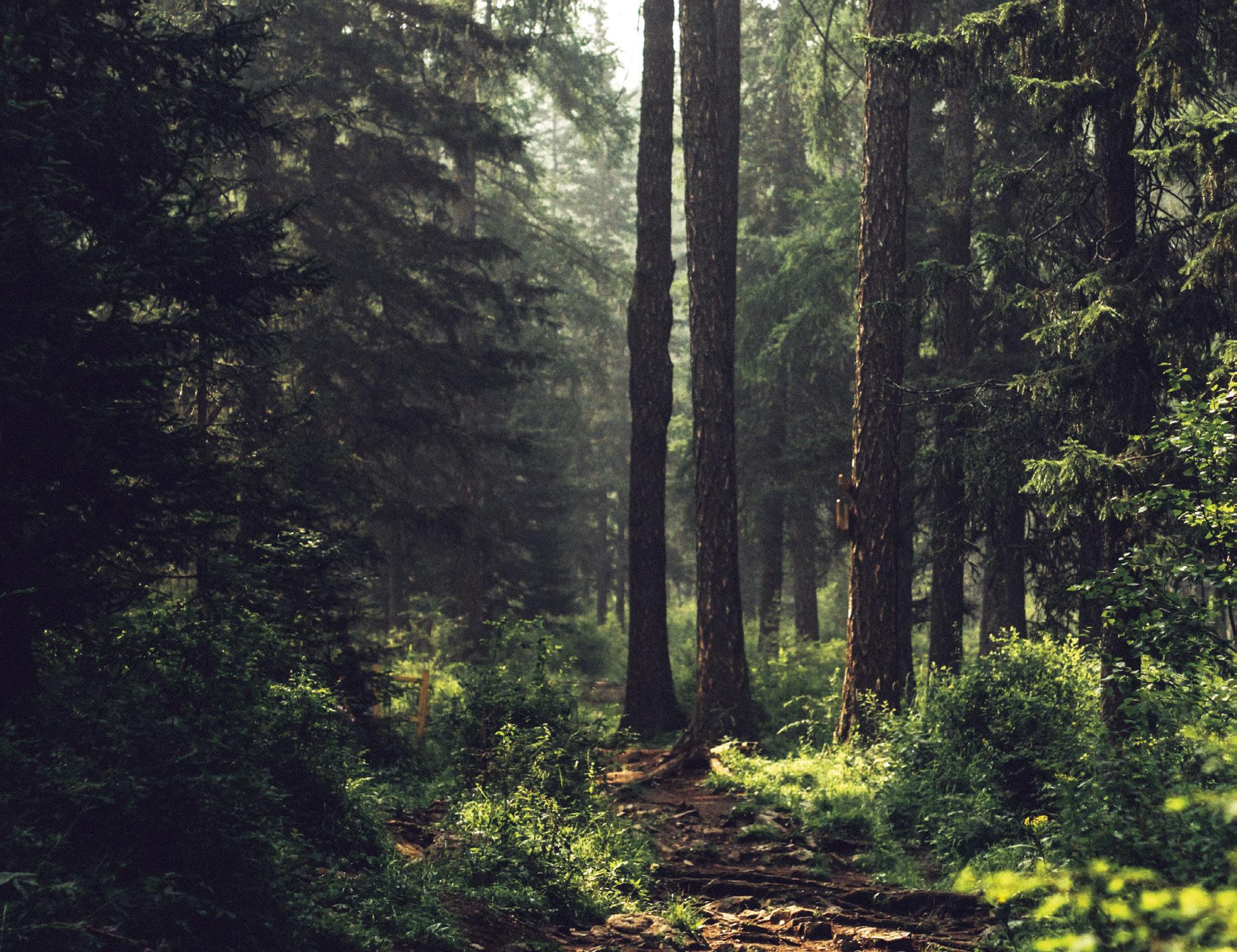

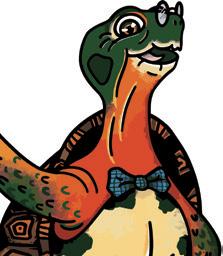


Meriden Road
CT
Nonprofit Organization US Postage PAID Hartford, CT Permit #1121 Dear Friend of the Forests, I think you’ll agree that Connecticut without forests is not a Connecticut we want to live in. Protect my forest home with a gift to CFPA’s 2022 Annual Fund. Slow and Steady for Our Forests, Woodrow W. Turtle, V.E.R. Woodrow W. Turtle Every $1 = $2 To protect our forests! Speed your giving at ctwoodlands.org/donate
16
Rockfall,
06481-2961











 Find the complete map in the Connecticut Walk Book, published by CFPA and Wesleyan University Press.
N
By Timothy Brown
Find the complete map in the Connecticut Walk Book, published by CFPA and Wesleyan University Press.
N
By Timothy Brown











































